32009L0158[1]
A Tanács 2009/158/EK irányelve ( 2009. november 30.) a baromfi és keltetőtojás Közösségen belüli kereskedelmére és harmadik országból történő behozatalára irányadó állat-egészségügyi feltételekről (kodifikált változat)
COUNCIL DIRECTIVE 2009/158/EC
of 30 November 2009
on animal health conditions governing intra-Community trade in, and imports from third countries of, poultry and hatching eggs
(codified version)
(Text with EEA relevance)
THE COUNCIL OF THE EUROPEAN UNION,
Having regard to the Treaty establishing the European Community, and in particular Article 37 thereof,
Having regard to the proposal from the Commission,
Having regard to the Opinion of the European Parliament ( 1 ),
Whereas:
(1) Council Directive 90/539/EEC of 15 October 1990 on animal health conditions governing intra-Community trade in, and imports from third countries of, poultry and hatching eggs ( 2 ) has been substantially amended several times ( 3 ). In the interests of clarity and rationality the said Directive should be codified.
(2) Poultry, being live animals, and hatching eggs, being animal products, are included in the list of products in Annex I to the Treaty.
(3) In order to ensure the rational development of poultry production, thereby increasing productivity in that sector, certain animal health rules governing intra-Community trade in poultry and hatching eggs should be laid down at Community level.
(4) The breeding and rearing of poultry is included in the farming sector. It constitutes a source of income for part of the farming population.
(5) In order to encourage intra-Community trade in poultry and hatching eggs, there should be no disparities as regards animal health conditions in the Member States.
(6) In order to encourage the harmonious development of intra-Community trade, a Community system should be laid down to govern imports from third countries.
(7) The provisions of this Directive should not, in principle, apply to specific trade such as exhibitions, shows and contests.
(8) In view of the nature of modern poultry farming, the best way to promote the harmonious development of intra-Community trade in poultry and hatching eggs is to monitor production establishments.
(9) It should be left to the competent authorities of the Member States to approve establishments which satisfy the conditions laid down in this Directive and to ensure that the conditions are applied.
(10) Council Regulation (EC) No 1234/2007 of 22 October 2007 establishing a common organisation of agricultural markets and on specific provisions for certain agricultural products (Single CMO Regulation) ( 4 ) provides for the marketing standards for products of the eggs and poultrymeat sectors. Commission Regulation (EC) No 617/2008 of 27 June 2008 laying down detailed rules for implementing Regulation (EC) No 1234/2007 as regards marketing standards for hatching eggs and farmyard poultry chicks ( 5 ) lays down detailed rules for implementing that Regulation as regards marketing standards for hatching eggs and farmyard poultry chicks, and in particular as regards the granting of a distinguishing number to each production establishment and for the marking of hatching eggs. For practical reasons, the same criteria for identifying production establishments and marking hatching eggs should be adopted for the purposes of this Directive.
(11) Member States should designate the national reference laboratories and provide all the necessary details and updates. Member States should make that information available to the other Member States and the public.
(12) In order to be the subject of intra-Community trade, poultry and hatching eggs should satisfy certain animal health requirements, so as to avoid the spread of contagious diseases.
(13) Transport conditions should be laid down for the same reason.
(14) Provision should be made for allowing the Commission to approve certain additional requirements in the light of the progress made by a Member State in eradicating certain poultry diseases, provided that those requirements in no case exceed those applied nationally by the Member State concerned. In this context, it could prove desirable to determine the status of the Member States or regions thereof with regard to certain diseases likely to affect poultry.
(15) Although intra-Community trade transactions in very small quantities cannot, for practical reasons, be subject to all the Community requirements, certain essential rules should be complied with.
(16) To ensure that the prescribed requirements are satisfied, provision should be made for the issue by an official veterinarian of a veterinary certificate to accompany the poultry and hatching eggs to their destination.
(17) In respect of the organisation of, and the follow-up to, the checks to be carried out by the Member State of destination and the safeguard measures to be implemented, reference should be made to the general rules laid down in Council Directive 90/425/EEC of 26 June 1990 concerning veterinary and zootechnical checks applicable in intra-Community trade in certain live animals and products with a view to the completion of the internal market ( 6 ).
(18) Provision should be made for checks to be carried out by the Commission in cooperation with the competent authorities of Member States.
(19) Defining Community arrangements applicable to imports from third countries requires a list to be drawn up of third countries or parts of third countries from which poultry and hatching eggs may be imported.
(20) The choice of those countries should be based on criteria of a general nature such as the state of health of the poultry and other livestock, the organisation and powers of the veterinary services and the health regulations in force.
(21) In addition, importation of poultry and hatching eggs should not be authorised from countries which are infected with contagious poultry diseases presenting a risk to Community livestock or which have been free from such diseases for too short a period.
(22) The general conditions applicable to importation from third countries should be supplemented by special conditions drawn up on the basis of the health situation in each of them.
(23) The presentation of a standard form of certificate upon importation of poultry and hatching eggs constitutes an effective means of verifying that the Community rules are being applied. Such rules may include special provisions which may vary according to the third country concerned. This should be taken into account in drawing up the standard forms of certificate.
(24) Commission veterinary experts should be responsible for verifying that the rules are observed in third countries.
(25) The checks carried out upon importation should cover the origin and the state of health of the poultry and hatching eggs.
(26) Member States should be allowed, on the arrival of poultry and hatching eggs in the territory of the Community and during transit to their place of destination, to take all measures, including slaughter and disposal, required for the purpose of safeguarding public and animal health.
(27) The constant development of poultry-rearing techniques means that periodic changes in the methods of poultry disease control will have to be made.
(28) The measures necessary for the implementation of this Directive should be adopted in accordance with Council Decision 1999/468/EC of 28 June 1999 laying down the procedures for the exercise of implementing powers conferred on the Commission ( 7 ).
(29) This Directive is without prejudice to the obligations of the Member States relating to the time-limits for transposition into national law of the Directives set out in Annex VI, Part B,
HAS ADOPTED THIS DIRECTIVE:
CHAPTER I
GENERAL PROVISIONS
Article 1
1. This Directive lays down animal health conditions governing intra-Community trade in, and imports from third countries of, poultry and hatching eggs.
2. This Directive shall not apply to poultry for exhibitions, show or contests.
Article 2
For the purposes of this Directive ‘official veterinarian' and ‘third country' mean the official veterinarian and third countries as defined in Council Directive 2004/68/EC of 26 April 2004 laying down animal health rules for the importation into and transit through the Community of certain live ungulate animals ( 8 ).
The following definitions shall also apply:
1. ‘poultry' means fowl, turkeys, guinea fowl, ducks, geese, quails, pigeons, pheasants, partridges and ratites (Ratitae) reared or kept in captivity for breeding, the production of meat or eggs for consumption, or for re-stocking supplies of game;
2. ‘hatching eggs' means eggs for incubation, laid by poultry;
3. ‘day-old chicks' means all poultry less than 72 hours old, not yet fed; however, muscovy ducks (Cairina moschata) or their crosses may be fed;
4. ‘breeding poultry' means poultry 72 hours old or more, intended for the production of hatching eggs;
5. ‘productive poultry' means poultry 72 hours old or more, reared for the production of meat and/or eggs for consumption (or for restocking supplies of game);
6. ‘slaughter poultry' means poultry sent direct to a slaughterhouse for slaughter as soon as possible after arrival, and in any case within 72 hours;
7. ‘flock' means all poultry of the same health status kept on the same premises or in the same enclosure and constituting a single epidemiological unit. In housed poultry this will include all birds sharing the same airspace;
8. ‘holding' means a facility - which may include an establishment - used for the rearing or keeping of breeding or productive poultry;
9. ‘establishment' means a facility or part of a facility which occupies a single site and is devoted to the following activities:
(a) pedigree breeding establishment: an establishment which produces hatching eggs for the production of breeding poultry;
(b) breeding establishment: an establishment which produces hatching eggs for the production of productive poultry;
(c) rearing establishment:
(i) either a breeding poultry-rearing establishment which is an establishment which rears breeding poultry prior to the reproductive stage;
or
(ii) a productive poultry-rearing establishment which is an establishment which rears egg-laying productive poultry prior to the laying stage;
(d) hatchery: an establishment which incubates and hatches eggs and supplies day-old chicks;
10. ‘authorised veterinarian' means a veterinarian instructed by the competent veterinary authority, under its responsibility, to carry out the checks provided for in this Directive in a particular establishment;
11. ‘approved laboratory' means a laboratory located in the territory of a Member State, approved by the competent veterinary authority, under its responsibility, for the purpose of carrying out the diagnostic tests provided for in this Directive;
12. ‘health inspection' means a visit by the official veterinarian or authorised veterinarian for the purpose of inspecting the health status of all the poultry in an establishment;
13. ‘compulsorily notifiable diseases' means the diseases listed in Annex V;
14. ‘outbreak' means an outbreak as defined in Council Directive 82/894/EEC of 21 December 1982 on the notification of animal diseases within the Community ( 9 );
15. ‘quarantine station' means facilities where the poultry is kept in complete isolation and away from direct or indirect contact with other poultry, so as to permit long-term observation and testing for the diseases listed in Annex V;
16. ‘sanitary slaughter' means the destruction, subject to all the necessary health safeguards including disinfection, of all poultry and products which are infected or suspected of being contaminated.
CHAPTER II
RULES FOR INTRA-COMMUNITY TRADE
Article 3
1. Member States shall submit to the Commission by 1 July 1991 a plan describing the national measures which they intend to implement to ensure compliance with the rules set out in Annex II for the approval of establishments for the purposes of intra-Community trade in poultry and hatching eggs.
The Commission shall examine the plans. In accordance with the procedure referred to in Article 33(2), those plans may be approved, or amendments or additions made, before approval is given.
2. In accordance with the procedure referred to in Article 33(2), amendments or additions to a plan which has been approved in accordance with the second subparagraph of paragraph 1 of this Article may be:
(a) approved at the request of the Member State concerned, in order to take account of a change in the situation in that Member State, or
(b) requested, in order to take account of progress in methods of disease prevention and control.
Article 4
Each Member State shall designate a national reference laboratory to be responsible for coordinating the diagnostic methods provided for in this Directive and their use by the approved laboratories located in its territory.
Each Member State shall make the details of its national reference laboratory, and any subsequent changes, available to the other Member States and to the public.
Detailed rules for the uniform application of this Article may be adopted in accordance with the procedure referred to in Article 33(2).
Article 5
In order to be traded in the Community:
(a) hatching eggs, day-old chicks, breeding poultry and productive poultry shall satisfy the conditions laid down in Articles 6, 15, 18 and 20. They shall also satisfy any conditions laid down pursuant to Articles 16 and 17.
In addition:
(i) hatching eggs shall satisfy the conditions laid down in Article 8;
(ii) day-old chicks shall satisfy the conditions laid down in Article 9;
(iii) breeding poultry and productive poultry shall satisfy the conditions laid down in Article 10;
(b) slaughter poultry shall fulfil the conditions set out in Articles 11, 15, 18 and 20 and those laid down pursuant to Articles 16 and 17;
(c) poultry (including day-old chicks) intended for restocking supplies of game shall fulfil the conditions set out in Articles 12, 15, 18 and 20 and those laid down pursuant to Articles 16 and 17;
(d) as regards salmonella, poultry intended for Finland and Sweden shall fulfil the conditions laid down pursuant to Article 13.
Article 6
Hatching eggs, day-old chicks, breeding poultry and productive poultry shall come from:
(a) establishments which fulfil the following requirements:
(i) they must be approved and given a distinguishing number by the competent authority, in accordance with the rules set out in Chapter I of Annex II;
(ii) they must not, at the time of consignment, be the subject of any animal health restrictions applicable to poultry;
(iii) they must not be located in an area which for animal health reasons is subject to restrictive measures in accordance with Community legislation as a result of the outbreak of a disease to which poultry is susceptible;
(b) a flock which at the time of consignment presents no clinical sign or suspicion of contagious poultry disease.
Article 7
Each Member State shall draw up and keep up-to-date a list of establishments approved in accordance with point (a)(i) of Article 6 and their distinguishing numbers, and shall make it available to the other Member States and to the public.
Detailed rules for the uniform application of this Article may be adopted in accordance with the procedure referred to in Article 33(2).
Article 8
1. At the time of consignment, hatching eggs shall:
(a) come from flocks which:
(i) have been held for more than six weeks in one or more Community establishments as referred to in Article 6(a)(i);
(ii) if vaccinated, have been vaccinated in accordance with the vaccination conditions in Annex III;
(iii) have either:
- undergone an animal health examination carried out by an official veterinarian or an authorised veterinarian during the 72 hours preceding consignment and, at the time of the examination, have shown no clinical sign or suspicion of contagious disease, or,
- had a monthly health inspection visit by an official veterinarian or an authorised veterinarian, the most recent visit having been within 31 days of consignment. If this option is chosen there shall also be an examination by the official veterinarian or authorised veterinarian of the records of the health status of the flock and an evaluation of its current health status as assessed by up-to-date information supplied by the person in charge of the flock during the 72 hours preceding consignment. In a case where records or other information give rise to suspicion of disease, the flocks shall have had an animal health examination by the official veterinarian or authorised veterinarian that has ruled out the possibility of contagious poultry disease;
(b) be marked in accordance with Regulation (EC) No 617/2008;
(c) have been disinfected in accordance with the instructions of the official veterinarian.
2. If contagious poultry diseases which may be transmitted through eggs develop in the flock which supplied the hatching eggs during the period of their incubation, the hatchery involved and the authority or authorities responsible for the hatchery and the flock of origin shall be notified.
Article 9
Day-old chicks shall:
(a) have been hatched from hatching eggs satisfying the requirements of Articles 6 and 8;
(b) satisfy the vaccination conditions in Annex III, if they have been vaccinated;
(c) present, at the time of consignment, no suspicion of diseases on the basis of Annex II, Chapter II, B2(g) and (h).
Article 10
At the time of consignment, breeding poultry and productive poultry shall:
(a) have been held since hatching or for more than six weeks in one or more Community establishments as referred to in Article 6(a)(i);
(b) satisfy the vaccination conditions in Annex III, if they have been vaccinated;
(c) have been submitted to a health examination by an official veterinarian or authorised veterinarian during the 48 hours preceding consignment and, at the time of the examination, have presented no clinical sign or suspicion of contagious poultry disease.
Article 11
At the time of the consignment, slaughter poultry shall have come from a holding:
(a) where they have been held since hatching or for more than 21 days;
(b) which is not the subject of any animal health restrictions applicable to poultry;
(c) where the health examination carried out by the official veterinarian or authorised veterinarian during the five days preceding dispatch on the flock from which the consignment to be slaughtered is to be drawn has not revealed within that flock any clinical sign or suspicion of contagious poultry disease;
(d) which is not located in an area which for animal health reasons is subject to restrictive measures in accordance with Community legislation as a result of the outbreak of a disease to which poultry is susceptible.
Article 12
1. At the time of consignment, poultry over 72 hours old intended for restocking supplies of wild game shall have come from a holding:
(a) where it has been held since hatching or for more than 21 days and where it has not been placed in contact with newly-arrived poultry during the two weeks preceding consignment;
(b) which is not the subject of any animal health restrictions applicable to poultry;
(c) where the health examination carried out by the official veterinarian or authorised veterinarian during the 48 hours preceding dispatch on the flock from which the consignment is to be drawn has not revealed within that flock any clinical sign or suspicion of contagious poultry disease;
(d) which is not located in an area which for animal health reasons is subject to prohibition in accordance with Community legislation as a result of an outbreak of disease to which poultry is susceptible.
2. Article 6 shall not apply to the poultry referred to in paragraph 1.
Article 13
1. As regards salmonella and in respect of serotypes not mentioned in Annex II, Chapter III(A), consignments of poultry for slaughter for Finland and Sweden shall be subject to a microbiological test by sampling in the establishment of origin in accordance with Council Decision 95/410/EC of 22 June 1995 laying down the rules for the microbiological testing by sampling in the establishment of origin of poultry for slaughter intended for Finland and Sweden ( 10 ).
2. The range of the test referred to in paragraph 1 and the methods to be adopted shall be determined in the light of the opinion of the European Food Safety Authority and of the operational programme which Finland and Sweden must submit to the Commission.
3. The test referred to in paragraph 1 shall not be carried out for slaughter poultry from a holding subject to a programme recognised as equivalent to that referred to in paragraph 2 in accordance with the procedure referred to in Article 33(2).
Article 14
1. The requirements of Articles 5 to 11 and 18 shall not apply to intra-Community trade in poultry and hatching eggs in respect of consignments comprising fewer than 20 units provided that they comply with paragraph 2 of this Article.
2. Poultry and hatching eggs as referred to in paragraph 1 shall, at the time of consignment, have come from flocks which:
(a) have been held in the Community since hatching or for at least three months;
(b) present no clinical signs of a contagious poultry disease at the time of consignment;
(c) satisfy the vaccination conditions in Annex III, if they have been vaccinated;
(d) are not the subject of any animal health restrictions applicable to poultry;
(e) are not located in an area which for animal health reasons is subject to restrictive measures in accordance with Community legislation as a result of an outbreak of disease to which poultry is susceptible.
All birds in the consignment shall have been found negative in serological tests for Salmonella pullorum and Salmonella gallinarum antibodies, in accordance with Annex II, Chapter III, in the month preceding the consignment. In the case of hatching eggs or day-old chicks, the flock of origin shall be tested serologically for Salmonella pullorum and Salmonella gallinarum in the three months preceding the consignment at a level which gives 95 % confidence of detecting infection at 5 % prevalence.
3. The provisions of paragraphs 1 and 2 shall not apply to consignments containing ratites or hatching eggs of ratites.
Article 15
1. In the case of consignments of poultry and hatching eggs from Member States or regions of Member States which vaccinate poultry against Newcastle disease to a Member State or region of a Member State the status of which has been established in accordance with paragraph 2, the following rules shall apply:
(a) hatching eggs shall come from flocks which are:
(i) not vaccinated, or
(ii) vaccinated using inactivated vaccine, or
(iii) vaccinated using a live vaccine, provided that vaccination has taken place at least 30 days before the collection of the hatching eggs;
(b) day-old chicks (including chicks intended for restocking supplies of game) shall not be vaccinated against Newcastle disease, and shall come from:
(i) hatching eggs satisfying the conditions in point (a), and
(ii) a hatchery where working practice ensures that such eggs are incubated at completely separate times and locations from eggs not satisfying the conditions in point (a);
(c) breeding and productive poultry shall:
(i) not be vaccinated against Newcastle disease, and
(ii) have been isolated for 14 days before consignment, at either a holding or a quarantine station under the supervision of the official veterinarian. In this connection, no poultry at the holding of origin or quarantine station, as applicable, may have been vaccinated against Newcastle disease during the 21 days preceding consignment and no bird which is not due for consignment may have entered the holding or the quarantine station during that time; in addition, no vaccination may be carried out in the quarantine stations, and
(iii) have undergone, during the 14 days preceding consignment, representative serological testing, with negative results, to detect Newcastle disease antibodies in accordance with detailed rules adopted in accordance with the procedure referred to in Article 33(2);
(d) slaughter poultry shall come from flocks which:
(i) if not vaccinated against Newcastle disease, satisfy the requirements of point (c)(iii);
(ii) if vaccinated, have undergone, during the 14 days preceding consignment and on the basis of a representative sample, a test to isolate Newcastle disease virus complying with detailed rules adopted in accordance with the procedure referred to in Article 33(2).
2. If a Member State or a region or regions of Member State wish to be established as Newcastle disease non-vaccinating they may present a programme as referred to in Article 16(1).
The Commission shall examine the programmes presented by the Member States. The programmes may be approved, in compliance with the criteria referred to in Article 16(1), in accordance with the procedure referred to in Article 33(2). Any additional guarantees, general or specific, which may be required in intra-Community trade may be defined in accordance with the same procedure.
Where a Member State or a region of a Member State considers it has achieved Newcastle disease non-vaccinating status, an application may be made to the Commission for Newcastle disease non-vaccinating status to be established in accordance with the procedure referred to in Article 33(2).
The elements to be taken into account for determination of a Member State's or region's status as Newcastle disease non-vaccinating shall be the data referred to in Article 17(1) and, in particular, the following criteria:
(a) vaccination against Newcastle disease in poultry shall not have been authorised for the preceding 12 months, except for the compulsory vaccination of racing pigeons referred to in Article 17(3) of Council Directive 92/66/EEC of 14 July 1992 introducing Community measures for the control of Newcastle disease ( 11 );
(b) breeding flocks shall have been serologically monitored at least once a year for the presence of Newcastle disease according to the detailed rules adopted in accordance with the procedure referred to in Article 33(2);
(c) the holdings shall contain no poultry which has been vaccinated against Newcastle disease in the previous 12 months, with the exception of racing pigeons vaccinated pursuant to Article 17(3) of Directive 92/66/EEC.
3. The Commission may suspend Newcastle disease non-vaccinating status in accordance with the procedure referred to in Article 33(2) in the event of either:
(a) a serious epizootic of Newcastle disease which is not being brought under control; or
(b) the removal of the legislative restrictions prohibiting systematic recourse to routine vaccination against Newcastle disease.
Article 16
1. Where a Member State draws up or has drawn up a voluntary or compulsory control programme for a disease to which poultry are susceptible, it may present the programme to the Commission, outlining in particular:
(a) the distribution of the disease in its territory;
(b) the reasons for the programme, taking into consideration the importance of the disease and the programme's likely benefit in relation to its cost;
(c) the geographical area in which the programme will be implemented;
(d) the status categories to be applied to poultry establishments, the standards which must be attained in each category, and the test procedures to be used;
(e) the programme monitoring procedures;
(f) the action to be taken if, for any reason, an establishment loses its status;
(g) the measures to be taken if the results of the tests carried out in accordance with the provisions of the programme are positive.
2. The Commission shall examine the programmes presented by the Member States. The programmes may be approved, in compliance with the criteria referred to in paragraph 1, in accordance with the procedure referred to in Article 33(2). Any additional guarantees, general or specific, which may be required in intra-Community trade may be defined in accordance with the same procedure. Such guarantees shall not exceed those required by the Member State in its own territory.
3. Programmes submitted by Member States may be amended or supplemented in accordance with the procedure referred to in Article 33(2). Amendments or additions to programmes which have already been approved or to guarantees which have been defined in accordance with paragraph 2 of this Article may be approved in accordance with the same procedure.
Article 17
1. Where a Member State considers that its territory or part of its territory is free from one of the diseases to which poultry are susceptible, it shall present to the Commission appropriate supporting documentation, setting out in particular:
(a) the nature of the disease and the history of its occurrence in that Member State;
(b) the results of surveillance testing based on serological, microbiological or pathological investigations and on the fact that the disease must by law be notified to the competent authorities;
(c) the period over which the surveillance was carried out;
(d) where applicable, the period during which vaccination against the disease has been prohibited and the geographical area concerned by the prohibition;
(e) the arrangements for verifying that the area concerned remains free from the disease.
2. The Commission shall examine documentation submitted by Member States. The additional guarantees, general or specific, which may be required in intra-Community trade may be defined in accordance with the procedure referred to in Article 33(2). Such guarantees shall not exceed those required by the Member State in its own territory.
3. The Member State concerned shall notify the Commission of any change in the particulars specified in paragraph 1. The guarantees defined pursuant to paragraph 2 may, in the light of such notification, be amended or withdrawn in accordance with the procedure referred to in Article 33(2).
Article 18
1. Day-old chicks and hatching eggs shall be transported in either:
(a) unused purpose-designed disposable containers to be used only once and then destroyed; or
(b) containers which may be re-used provided they are cleaned and disinfected beforehand.
2. In any event the containers referred to in paragraph 1 shall:
(a) contain only day-old chicks or hatching eggs of the same species, category and type of poultry, coming from the same establishment;
(b) be labelled with:
(i) the name of the Member State and region of origin;
(ii) the establishment of origin's approval number as provided for in Annex II, Chapter I(2);
(iii) the number of chicks or eggs in each box;
(iv) the poultry species to which the eggs or chicks belong.
3. Boxes holding day-old chicks or hatching eggs may be grouped for transport in appropriate containers. The number of boxes thus grouped and the indications referred to in paragraph 2(b) shall be shown on those containers.
4. Breeding and productive poultry shall be transported in crates or cages:
(a) which contain only poultry of the same species, categories and type, coming from the same establishment;
(b) bearing the approval number of the establishment of origin as provided for in Annex II, Chapter I(2).
5. Breeding and productive poultry and day-old chicks shall be conveyed without delay to the establishment of destination, without coming into contact with other live birds, except breeding and productive poultry or day-old chicks satisfying the conditions laid down in this Directive.
Slaughter poultry shall be conveyed without delay to the slaughterhouse of destination, without coming into contact with other poultry, except slaughter poultry satisfying the conditions laid down in this Directive.
Poultry intended for restocking supplies of game shall be conveyed without delay to the point of destination without coming into contact with other poultry except poultry intended for restocking supplies of game satisfying the conditions laid down in this Directive.
6. Crates, cages and vehicles shall be designed so as to:
(a) preclude the loss of excrement and minimise the loss of feathers during transit;
(b) allow visual inspection of the poultry;
(c) allow cleansing and disinfection.
7. The vehicles and, if they are not disposable, the containers, crates and cages shall, before loading and unloading, be cleansed and disinfected in accordance with the instructions of the competent authority of the Member State concerned.
Article 19
Poultry as referred to in Article 18(5) may not be transported through areas infected with avian influenza or Newcastle disease, unless by trunk road or rail.
Article 20
In trade between Member States, poultry and hatching eggs shall, during transportation to the place of destination, be accompanied by a veterinary certificate which:
(a) conforms with the appropriate model laid down in Annex IV, completed in accordance with Commission Regulation (EC) No 599/2004 of 30 March 2004 concerning the adoption of a harmonised model certificate and inspection report linked to intra-Community trade in animals and products of animal origin ( 12 );
(b) is signed by an official veterinarian;
(c) is drawn up on the date of loading in the official language or languages of the Member State of dispatch and in the official language or languages of the Member State of destination;
(d) is valid for five days;
(e) consists of a single sheet;
(f) is normally made out for a single consignee;
(g) bears a stamp and a signature of a different colour from that of the certificate.
Article 21
The Member States of destination may, in compliance with the general provisions of the Treaty, grant one or more Member States of dispatch general authorisations or authorisations limited to specific cases permitting entry into their territory of poultry and hatching eggs without the certificate provided for in Article 20.
CHAPTER III
RULES FOR IMPORTS FROM THIRD COUNTRIES
Article 22
Poultry and hatching eggs imported into the Community shall satisfy the conditions laid down in Articles 23 to 26.
Article 23
1. Poultry and hatching eggs shall have originated in a third country or part of a third country included on a list drawn up by the Commission in accordance with the procedure referred to in Article 33(2). That list may be supplemented or amended in accordance with the procedure referred to in Article 33(3).
2. In deciding whether a third country or part thereof may be included on the list referred to in paragraph 1, particular account shall be taken of:
(a) the state of health of the poultry, other domestic animals and wildlife in the third country, particular attention being paid to exotic animal diseases, and the health situation in the surrounding area, where either is liable to endanger public and animal health in the Member States;
(b) the regularity and rapidity of the supply of information by the third country relating to the existence of contagious animal diseases in its territory, in particular the diseases on the list of the World Organisation for Animal Health (OIE);
(c) the country's rules on animal-disease prevention and control;
(d) the structure of the veterinary services in the country and their powers;
(e) the organisation and implementation of measures to prevent and control contagious animal diseases;
(f) the guarantees which the third country can give with regard to compliance with this Directive;
(g) compliance with Community rules on hormones and residues.
3. The list referred to in paragraph 1 and any amendments thereto shall be published in the Official Journal of the European Union.
Article 24
1. Poultry and hatching eggs shall come from third countries:
(a) in which avian influenza and Newcastle disease, as defined in Council Directive 2005/94/EC of 20 December 2005 on Community measures for the control of avian influenza ( 13 ) and Directive 92/66/EEC respectively, are legally notifiable diseases;
(b) free from avian influenza and Newcastle disease,
or
which, although they are not free from these diseases, apply measures to control them which are at least equivalent to those laid down in Directives 2005/94/EC and 92/66/EEC respectively.
2. The Commission may, in accordance with the procedure referred to in Article 33(2), decide under which conditions paragraph 1 of this Article is to apply only to a part of the territory of third countries.
Article 25
1. Poultry and hatching eggs may be imported from the territory of a third country or part of the territory of a third country included on the list drawn up in accordance with Article 23(1) only if they come from flocks which:
(a) prior to consignment have been held without interruption in the territory or part of the territory concerned of such country for a period to be determined in accordance with the procedure referred to in Article 33(2);
(b) satisfy the animal health conditions adopted in accordance with the procedure referred to in Article 33(2) for imports of poultry and hatching eggs from the country in question. The conditions may differ according to the species or category of poultry.
2. The animal health conditions shall be determined on the basis of the rules laid down in Chapter II and its corresponding Annexes. In accordance with the procedure referred to in Article 33(2), derogations may be granted on a case-by-case basis if the third country concerned offers similar animal health guarantees which are at least equivalent.
Article 26
1. Poultry and hatching eggs shall be accompanied by a certificate drawn up and signed by an official veterinarian of the exporting third country.
The certificate shall:
(a) be issued on the day of loading for consignment to the Member State of destination;
(b) be drawn up in the official language or languages of the Member State of destination;
(c) accompany the consignment in the original;
(d) attest to the fact that the poultry or hatching eggs satisfy the requirements of this Directive and those adopted pursuant to this Directive with regard to importation from third countries;
(e) be valid for five days;
(f) consist of a single sheet;
(g) be made out for a single consignee;
(h) bear a stamp and a signature of a different colour from that of the certificate.
2. The certificate referred to in paragraph 1 shall comply with a model drawn up in accordance with the procedure referred to in Article 33(2).
Article 27
On-the-spot inspections shall be carried out by veterinary experts of the Member States and the Commission to ensure that all the provisions of this Directive are effectively applied.
The Member States' experts responsible for those inspections shall be designated by the Commission on proposals from the Member States.
The inspections shall be carried out on behalf of the Community, and the latter shall bear the costs thereof.
The frequency of the inspections and the inspection procedure shall be determined in accordance with the procedure referred to in Article 33(2).
Article 28
1. The Commission may, in accordance with the procedure referred to in Article 33(3), decide that imports from a third country or part of a third country are to be confined to particular species, to hatching eggs, to breeding or productive poultry, to slaughter poultry or to poultry intended for special purposes.
2. The Commission may, in accordance with the procedure referred to in Article 33(2), determine that the imported poultry, hatching eggs or poultry hatched from imported eggs is to be kept quarantined or isolated for a period which may not exceed two months.
Article 29
Notwithstanding Articles 22, 24, 25 and 26, the Commission may, in accordance with the procedure referred to in Article 33(2), decide to permit on a case-by-case basis the importation of poultry and hatching eggs from third countries where such imports do not conform to the provisions of Articles 22, 24, 25 and 26. Detailed rules for such importation shall be drawn up at the same time in accordance with the same procedure. Such rules shall offer animal health guarantees at least equivalent to the animal health guarantees offered by Chapter II, involving compulsory quarantine and testing for avian influenza, Newcastle disease and any other relevant disease.
Article 30
On arrival in the Member State of destination, slaughter poultry shall be taken directly to a slaughterhouse for slaughter as soon as possible.
Without prejudice to any special conditions which may be adopted in accordance with the procedure referred to in Article 33(3), the competent authority of the Member State of destination may, on animal-health grounds, designate the slaughterhouse to which the poultry must be conveyed.
CHAPTER IV
COMMON PROVISIONS
Article 31
For the purposes of intra-Community trade, the safeguard measures provided for in Council Directive 89/662/EEC of 11 December 1989 concerning veterinary checks in intra-Community trade with a view to the completion of the internal market ( 14 ) shall apply to poultry and hatching eggs.
Article 32
The veterinary control rules provided for by Directive 90/425/EEC shall apply to intra-Community trade in poultry and hatching eggs.
Article 33
1. The Commission shall be assisted by the Standing Committee on the Food Chain and Animal Health set up pursuant to Article 58 of Regulation (EC) No 178/2002 of the European Parliament and of the Council of 28 January 2002 laying down the general principles and requirements of food law, establishing the European Food Safety Authority and laying down procedures in matters of food safety ( 15 ).
2. Where reference is made to this paragraph, Articles 5 and 7 of Decision 1999/468/EC shall apply.
The period laid down in Article 5(6) of Decision 1999/468/EC shall be set at three months.
3. Where reference is made to this paragraph, Articles 5 and 7 of Decision 1999/468/EC shall apply.
The period laid down in Article 5(6) of Decision 1999/468/EC shall be set at 15 days.
Article 34
Amendments to Annexes I to V, particularly in order to adapt them to changes in diagnostic methods and to variations in the economic importance of particular diseases, shall be decided in accordance with the procedure referred to in Article 33(2).
Article 35
Member States shall communicate to the Commission the text of the provisions of national law which they adopt in the field covered by this Directive.
Article 36
Directive 90/539/EEC, as amended by the acts listed in Annex VI, Part A, is repealed, without prejudice to the obligations of the Member States relating to the time-limits for transposition into national law of the Directives set out in Annex VI, Part B.
References to the repealed Directive shall be construed as references to this Directive and shall be read in accordance with the correlation table in Annex VII.
Article 37
This Directive shall enter into force on the 20th day following its publication in the Official Journal of the European Union.
It shall apply from 1 January 2010.
Article 38
This Directive is addressed to the Member States.
ANNEX I
The national reference laboratories for avian diseases designated in accordance with Article 4 shall be responsible in each Member State for coordinating the diagnostic methods provided for in this Directive. To this end:
(a) they may supply approved laboratories with the reagents needed for diagnostic testing;
(b) they shall monitor the quality of reagents used by the laboratories approved for the purpose of carrying out the diagnostic tests provided for in this Directive;
(c) they shall organise periodic comparative tests.
ANNEX II
APPROVAL OF ESTABLISHMENTS
CHAPTER I
GENERAL RULES
1. In order to be approved by the competent authority for the purposes of intra-Community trade, establishments must:
(a) satisfy the conditions as regards facilities and operation set out in Chapter II;
(b) apply and adhere to a disease surveillance programme approved by the competent central veterinary authority, taking into account the requirements of Chapter III;
(c) provide every facility for the carrying out of the operations listed in point (d);
(d) be subject to the supervision of the competent veterinary authority within the context of an organised form of animal health monitoring. Such monitoring shall include in particular:
- at least one inspection visit per year by the official veterinarian, supplemented by checks to verify the application of hygiene measures and the operation of the establishment in accordance with the conditions in Chapter II,
- the recording by the farmer of all the information necessary for the continuous monitoring of the health status of the establishment by the competent veterinary authority,
(e) contain only poultry.
2. The competent authority shall give each establishment which complies with the conditions laid down in point 1 a distinguishing number, which may be the same as that given pursuant to Regulation (EC) No 1234/2007.
CHAPTER II
FACILITIES AND OPERATION
A. Pedigree breeding, breeding and rearing establishments
1. Facilities
(a) The setting and layout of the facilities must be compatible with the type of production pursued, ensuring that the introduction of disease can be prevented or, if an outbreak occurs, that it can be controlled. If an establishment houses several species of poultry, there must be a clear separation between them.
(b) The facilities must provide good conditions of hygiene and allow health monitoring to be carried out.
(c) The equipment must be compatible with the type of production pursued, and allow cleansing and disinfection of the facilities and of vehicles for transporting poultry and eggs at the most suitable spot.
2. Rearing
(a) Rearing techniques must be based as far as possible on the ‘protected rearing' principle and on the ‘all-in/all-out' principle. Cleansing, disinfection and depopulation must be carried out between batches.
(b) Pedigree-breeding, breeding and rearing establishments must house only poultry:
- from the establishment itself, and/or,
- from other pedigree-breeding, breeding or rearing establishments in the Community approved in accordance with Article 6(a)(i), and/or,
- imported from third countries in accordance with this Directive,
(c) Hygiene rules must be drawn up by the management of the establishment; personnel must wear appropriate working clothing and visitors protective clothing.
(d) Buildings, pens and equipment must be kept in good repair.
(e) Eggs must be:
(i) collected at frequent intervals, at least daily and as soon as possible after laying;
(ii) cleaned and disinfected as soon as possible, unless disinfection takes place at a hatchery in the same Member State;
(iii) placed either in new or in clean and disinfected packaging material.
(f) The farmer must notify the authorised veterinarian of any variation in production performance or any other sign suggesting the presence of a contagious poultry disease. As soon as disease is suspected, the authorised veterinarian must send the samples needed for making or confirming the diagnosis to an approved laboratory.
(g) A flock history, register or data medium must be kept for each flock for at least two years after the disposal of the flock and must show:
- arrivals and departures,
- production performance,
- morbidity and mortality with causes,
- any laboratory tests and the results thereof,
- the place of origin of the poultry,
- the destination of eggs,
(h) Where a contagious poultry disease occurs, the results of laboratory tests must be communicated immediately to the authorised veterinarian.
B. Hatcheries
1. Facilities
(a) A hatchery must be physically and operationally separate from rearing facilities. The layout must be such as to allow the various functional units listed below to be kept separate:
- egg storage and grading,
- disinfection,
- pre-incubation,
- hatching,
- preparation and packaging of goods for dispatch,
(b) Buildings must be protected against birds coming from outside and rodents; floors and walls must be of hard-wearing, impervious and washable materials; natural or artificial lighting and air flow and temperature systems must be of an appropriate type; provision must be made for the hygienic evacuation of waste (eggs and chicks).
(c) Equipment must have smooth and waterproof surfaces.
2. Operation
(a) Operation must be based on a one-way circuit for eggs, mobile equipment and personnel.
(b) Hatching eggs must be:
- from Community pedigree breeding or breeding establishments approved in accordance with Article 6(a)(i),
- imported from third countries in accordance with this Directive,
(c) Hygiene rules must be drawn up by the management of the establishment; personnel must wear appropriate working clothing and visitors protective clothing.
(d) Buildings and equipment must be kept in good repair.
(e) The following must be disinfected:
- eggs, between the time of their arrival at the hatchery and the incubation process or at the time of their dispatch for trade within the Union or export to a third country, unless they have been previously disinfected at the breeding establishment of origin,
- the incubators, regularly,
- hatchers and equipment, after the hatching of each batch,
(f) A programme of microbiological quality control must be used to assess the health status of the hatchery.
(g) The farmer must notify the authorised veterinarian of any variation in production performance or any other sign suggesting the presence of a contagious poultry disease. As soon as contagious disease is suspected, the authorised veterinarian must send the samples needed for making or confirming the diagnosis to an approved laboratory and inform the competent veterinary authority, which shall decide on appropriate measures to be taken.
(h) A flock history, register or data medium for the hatchery must be kept for at least two years showing, if possible by flock:
- the origin of the eggs and their arrival date,
- hatching yields,
- any abnormalities,
- any laboratory tests and the results thereof,
- details of any vaccination programmes,
- the number and the destination of incubated eggs which have not hatched,
- the destination of day-old chicks,
(i) Where a contagious poultry disease occurs, the results of laboratory tests must be communicated immediately to the authorised veterinarian.
CHAPTER III
DISEASE SURVEILLANCE PROGRAMME
Without prejudice to health measures and to Articles 16 and 17, disease surveillance programmes must, as a minimum, comprise surveillance of the infections and species listed in Sections A to D.
A. Salmonella Pullorum ( 16 ), Salmonella Gallinarum ( 17 ) and Salmonella arizonae ( 18 ) infections
1. Species concerned
(a) Salmonella Pullorum and Salmonella Gallinarum: fowls, turkeys, guinea fowls, quails, pheasants, partridges and ducks.
(b) Salmonella arizonae: turkeys.
2. Disease surveillance programme
(a) Serological and/or bacteriological tests must be used to determine whether an infection is present ( 19 ).
(b) Samples for testing must be taken, as appropriate, from blood, embryos that fail to hatch (namely embryos dead-in-shell), second grade chicks, meconium, post mortem tissues, especially liver, spleen, ovary/oviduct and ileo-caecal junction ( 20 ).
(c) Direct enrichment in Selenite-cysteine broth for faecal/meconium and intestinal samples is to be used. Non-selective pre-enrichment followed by selective enrichment in soya based Rappaport-Vassiliadis (RVS) broth or Müller-Kauffmann Tetrathionate-novobiocin broth (MKTTn) may be used for samples (such as embryos dead-in-shell) where competing flora is expected to be minimal ( 21 ), ( 22 ).
(d) When blood samples are taken from a flock for serological testing for Salmonella Pullorum and Salmonella Gallinarum or Salmonella arizonae, the prevalence of infection in the Member State concerned and its past incidence in the establishment must be allowed for in determining the number of samples to be taken. However, a statistically valid number of samples for serological and/or bacteriological testing to detect infection must always be taken.
(e) Flocks must be inspected during each laying period at the best time for detecting the disease in question.
(f) Samples for bacteriological testing must not be taken from poultry or eggs that have been treated with antimicrobial medicinal products during the 2 to 3 weeks prior to testing.
(g) Detection techniques must be capable of differentiating serological responses to Salmonella Pullorum and Salmonella Gallinarum infection from serological responses due to the use of Salmonella Enteritidis vaccine, where this vaccine is used ( 23 ). Such vaccination must therefore not be used if serological monitoring is to be used. If vaccination has been used, bacteriological testing must be used, but the confirmation method used must be capable of differentiating live vaccinal strains from field strains.
B. Mycoplasma gallisepticum and Mycoplasma meleagridis infections
1. Species concerned
(a) Mycoplasma gallisepticum: fowls and turkeys.
(b) Mycoplasma meleagridis: turkeys.
2. Disease surveillance programme
(a) The presence of infection must be tested by validated serological and/or bacteriological and/or molecular tests. The presence of air sacculitis lesions in day-old chicks and turkey poults suggests that a Mycoplasma infection is present and must be investigated.
(b) Samples for testing for the presence of Mycoplasma infection must be taken, as appropriate, from blood, day-old chicks and turkey poults, sperm, or swabs taken from the trachea, the choanae, cloaca or air sacs and in particular for the detection of Mycoplasma meleagridis samples must be taken from oviduct and penis of turkeys.
(c) Tests for detecting Mycoplasma gallisepticum or Mycoplasma meleagridis must be performed on a representative sample in order to allow continuous surveillance of the infection during rearing and laying, namely just before the start of laying and every 3 months thereafter.
C. Results and measures to be taken
If there are no reactors, the test must be deemed to be negative. Otherwise, the flock must be deemed to be suspect and the measures set out in Chapter IV must be applied to it.
D. In the case of holdings which consist of two or more separate production units, the competent veterinary authority may derogate from the measures set out in point 3(b) of Chapter IV required for restoring of approval as regards healthy production units on a holding where the infection is present provided that the authorised veterinarian has confirmed that the structure and size of those production units and the operations carried out there are such that the production units provide completely separate facilities for housing, keeping and feeding, so that the disease in question cannot spread from one production unit to another. - CHAPTER IV
CRITERIA FOR SUSPENDING OR WITHDRAWING APPROVAL OF AN ESTABLISHMENT
1. Approval granted to an establishment must be suspended:
(a) when the conditions laid down in Chapter II are no longer met;
(b) until an investigation appropriate to the disease has been completed,
if:
- an outbreak of avian influenza or Newcastle disease is suspected at the establishment,
- the establishment has received poultry or hatching eggs from an establishment with a suspected or confirmed outbreak of avian influenza or Newcastle disease,
- contact liable to transmit the infection has occurred between the establishment and the site of an outbreak of avian influenza or Newcastle disease;
(c) until such time as new tests are performed, if the results of surveillance carried out in accordance with the conditions laid down in Chapters II and III for infection by Salmonella Pullorum, Salmonella Gallinarum, Salmonella arizonae, Mycoplasma gallisepticum or Mycoplasma meleagridis give cause to suspect an outbreak;
(d) until completion of the appropriate measures required by the official veterinarian, if the establishment is found not to conform with the requirements of point 1(a), (b) and (c) of Chapter I.
2. Approval must be withdrawn if:
(a) an outbreak of avian influenza or Newcastle disease is confirmed on the establishment;
(b) a second test of an appropriate type confirms an outbreak of infection by Salmonella Pullorum, Salmonella Gallinarum, Salmonella arizonae, Mycoplasma gallisepticum or Mycoplasma meleagridis;
(c) after a second notice served by the official veterinarian on the person responsible for the establishment, action to bring the establishment into line with the requirements of point 1(a), (b) and (c) of Chapter I, has not been taken.
3. Conditions for restoring approval if:
(a) approval has been withdrawn because of an outbreak of avian influenza or Newcastle disease, it may be restored 21 days after cleansing and disinfection if sanitary slaughter has been carried out;
(b) approval has been withdrawn because of an outbreak caused by:
- Salmonella Pullorum and Salmonella Gallinarum, or Salmonella arizonae, it may be restored after negative results have been recorded in two tests performed with an interval of at least 21 days on the establishment following sanitary slaughter of the infected flock and after disinfection for which the effectiveness has been verified by suitable tests on dried surfaces,
- Mycoplasma gallisepticum or Mycoplasma meleagridis, it may be restored either after negative results have been recorded in two tests performed on the entire flock with an interval of at least 60 days or after negative results have been recorded in two tests performed with an interval of at least 21 days on the establishment after disinfection following sanitary slaughter of the entire infected flock.
ANNEX III
POULTRY VACCINATION CONDITIONS
1. Vaccines used for vaccinating poultry or flocks producing hatching eggs must have a marketing authorisation issued by the competent authority of any Member State.
2. The criteria for using vaccines against Newcastle disease in the context of routine-vaccination programmes may be determined by the Commission.
3. In relation to vaccination against any Salmonella serotype the following conditions shall be met:
(a) Salmonella vaccination programmes must not interfere with serological detection in the context of field investigation, or result in false-positive tests;
(b) live Salmonella vaccines must not be used in the framework of national control programmes:
(i) in breeding or productive poultry during their reproductive or laying stage unless the safety of their use has been demonstrated and they are authorised for such purpose in accordance with Directive 2001/82/EC of the European Parliament and of the Council ( 24 );
(ii) where the manufacturer does not provide an appropriate method to distinguish bacteriologically wild-type strains of Salmonella from vaccine strains.
ANNEX IV
VETERINARY CERTIFICATES FOR TRADE WITHIN THE UNION
(Models 1 to 6)
MODEL 1
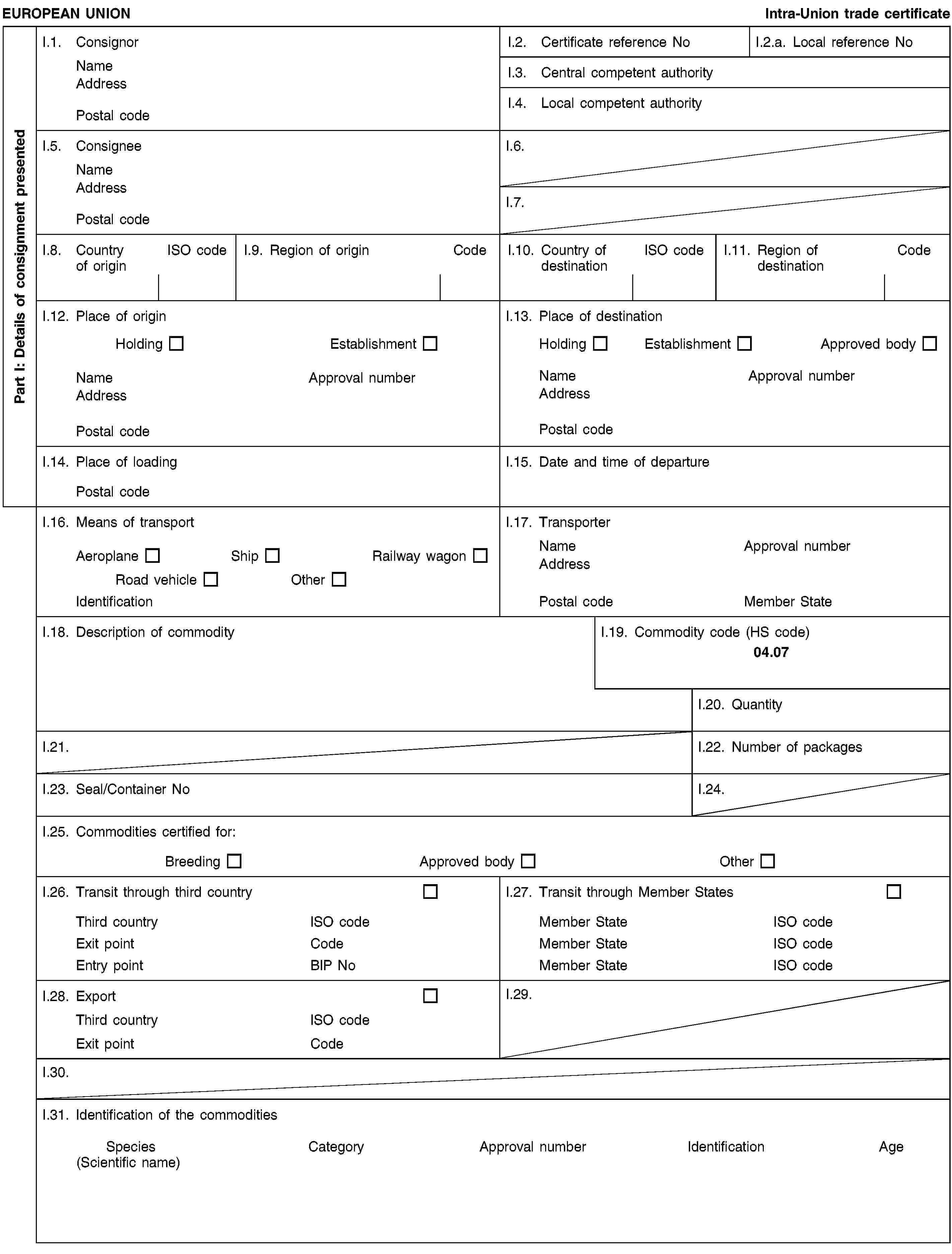
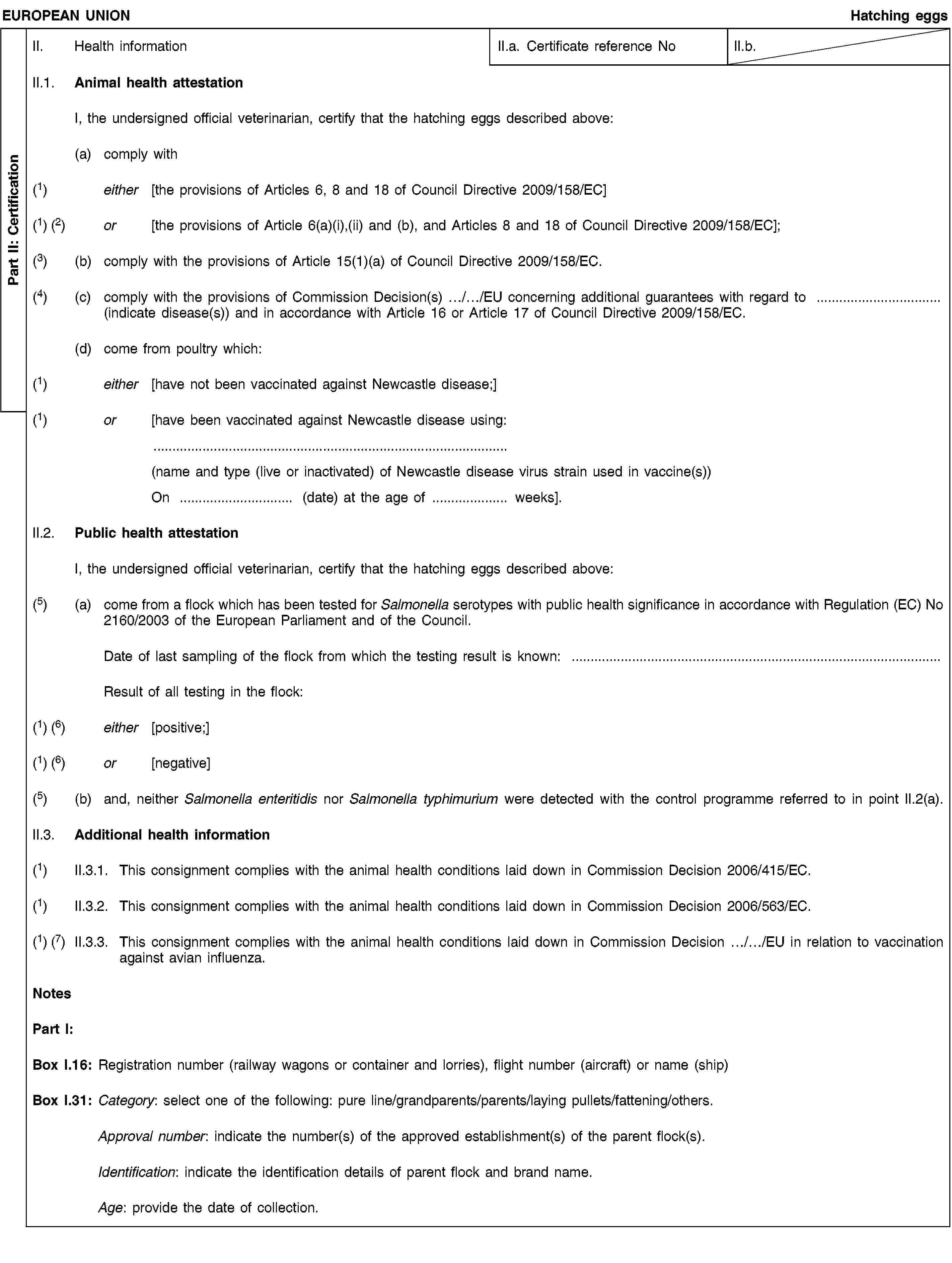
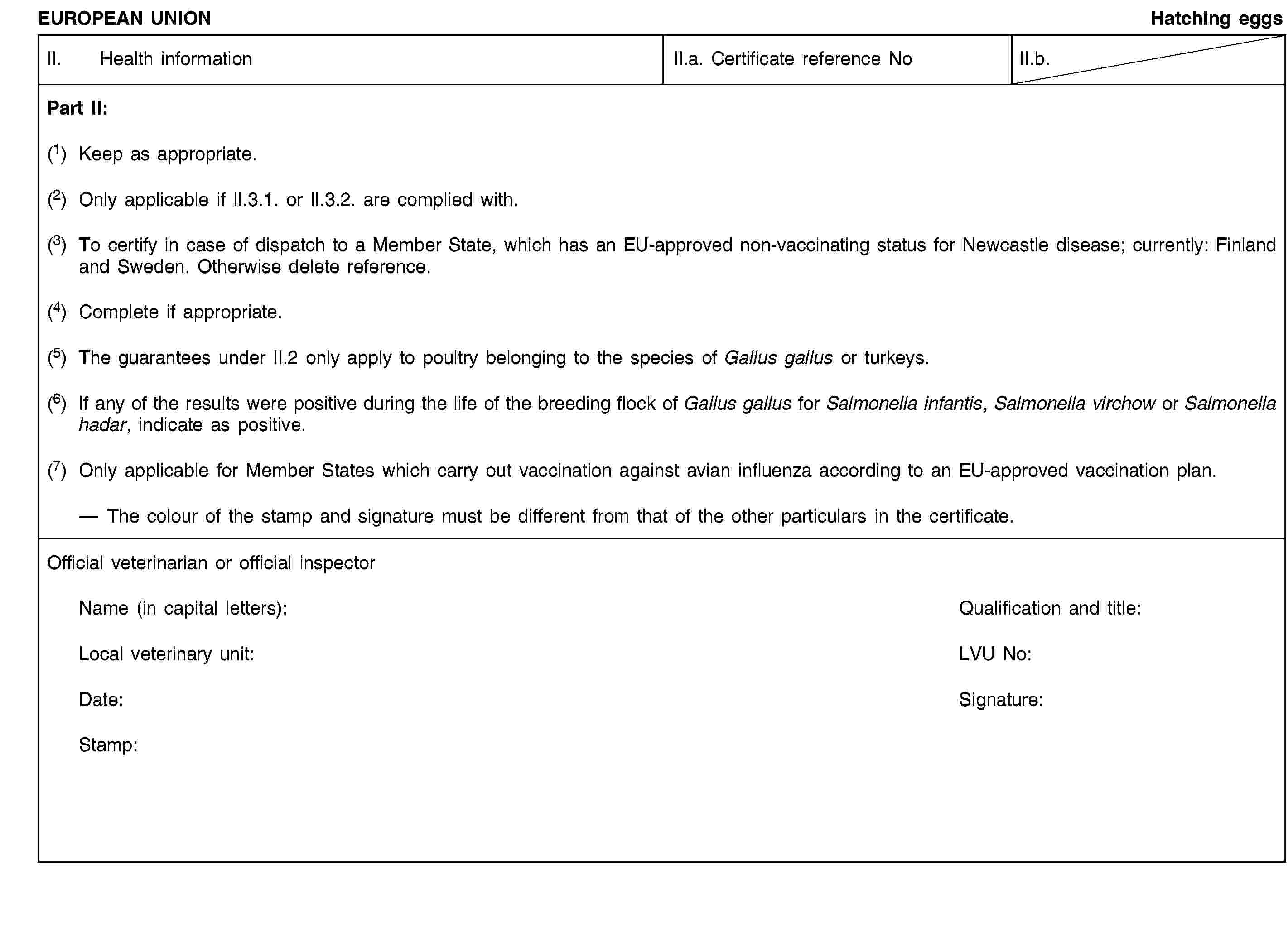
MODEL 2
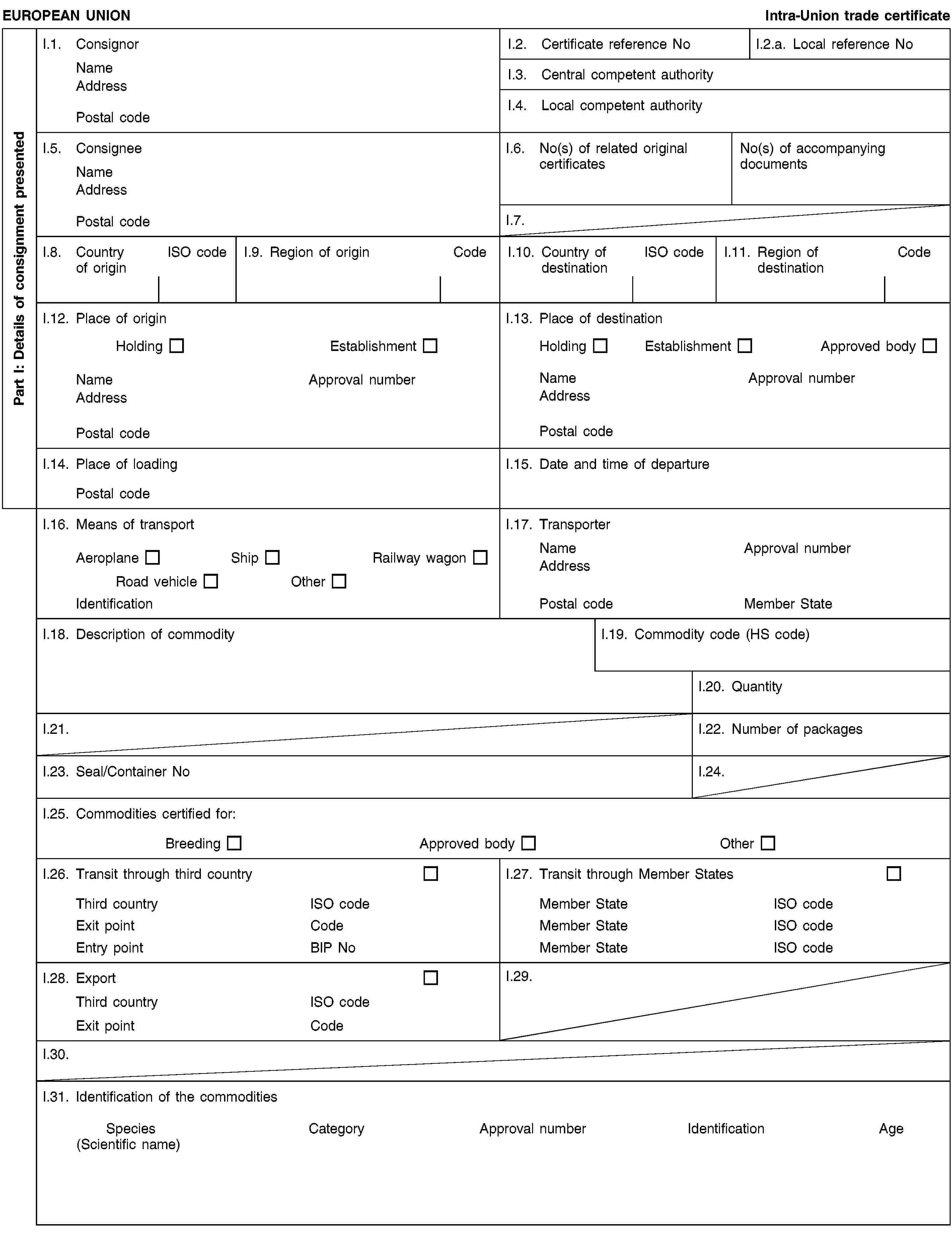
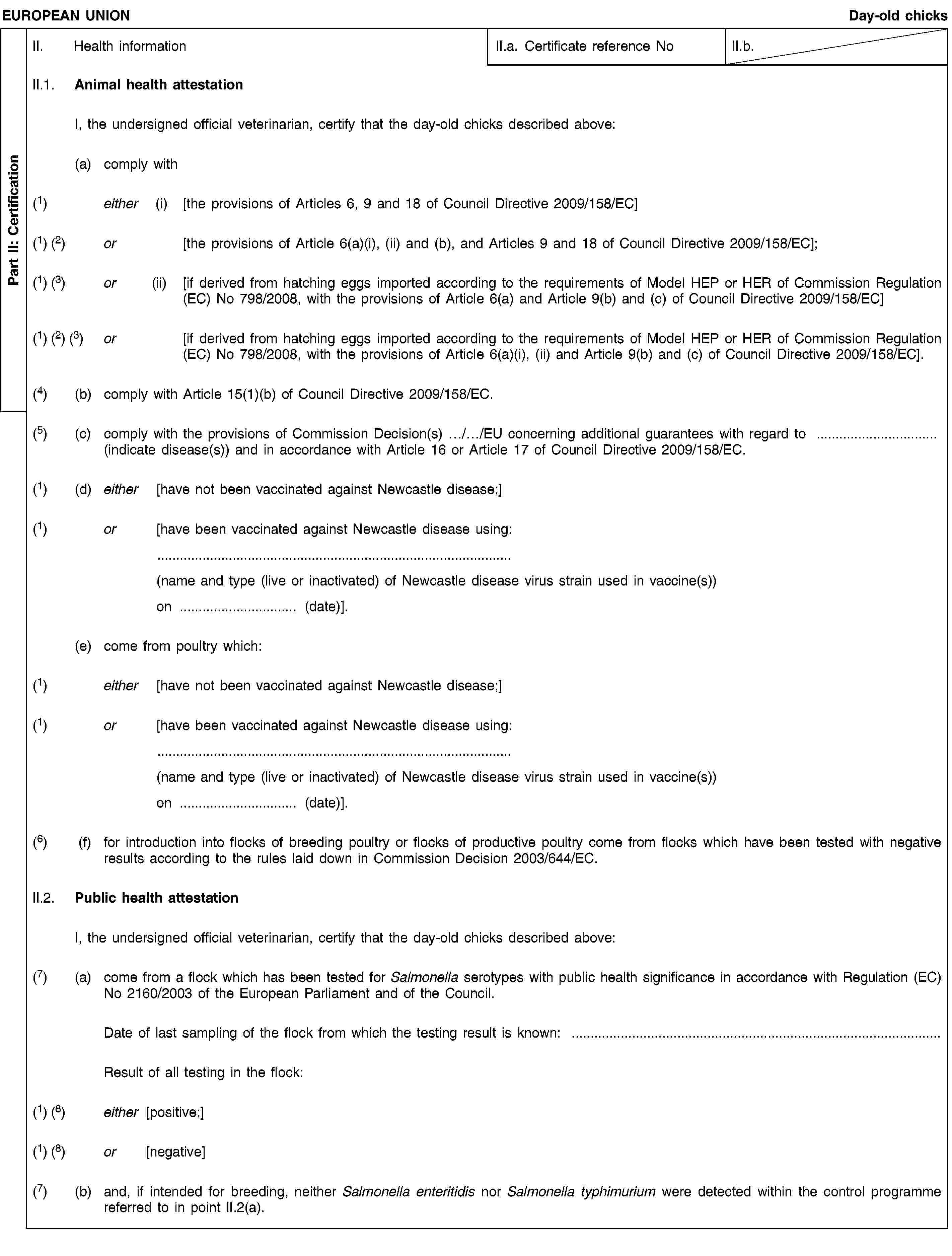
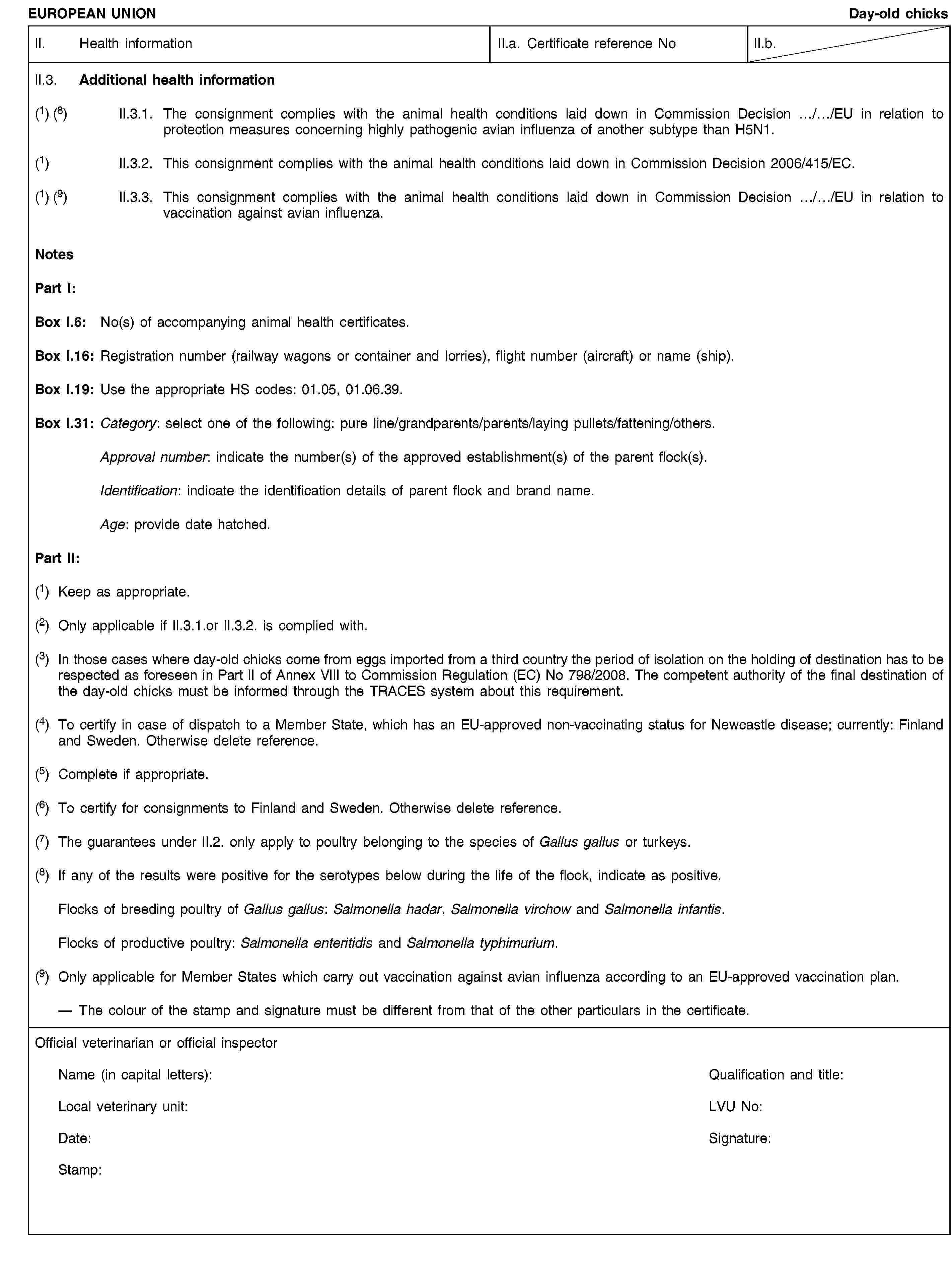
MODEL 3

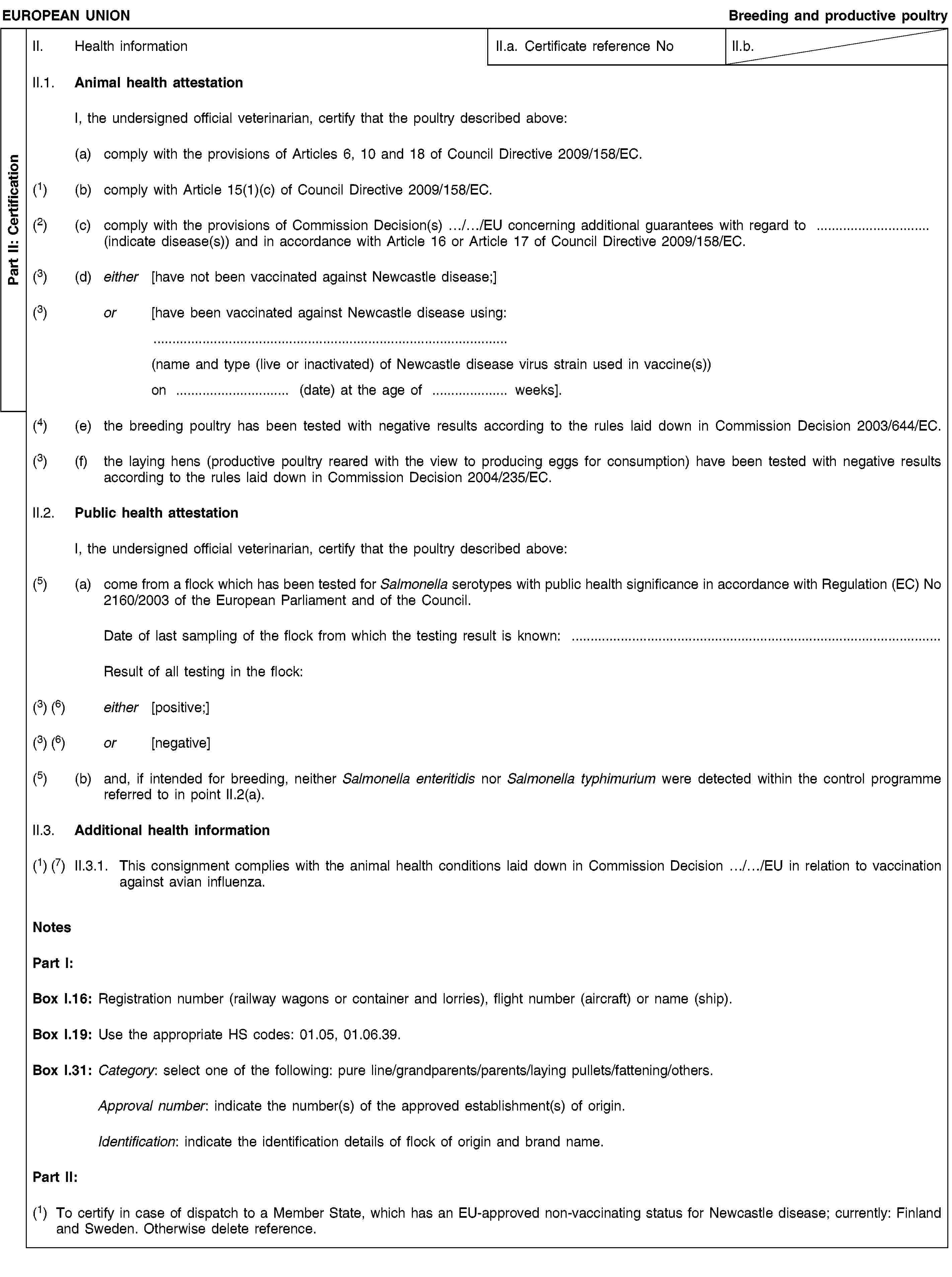
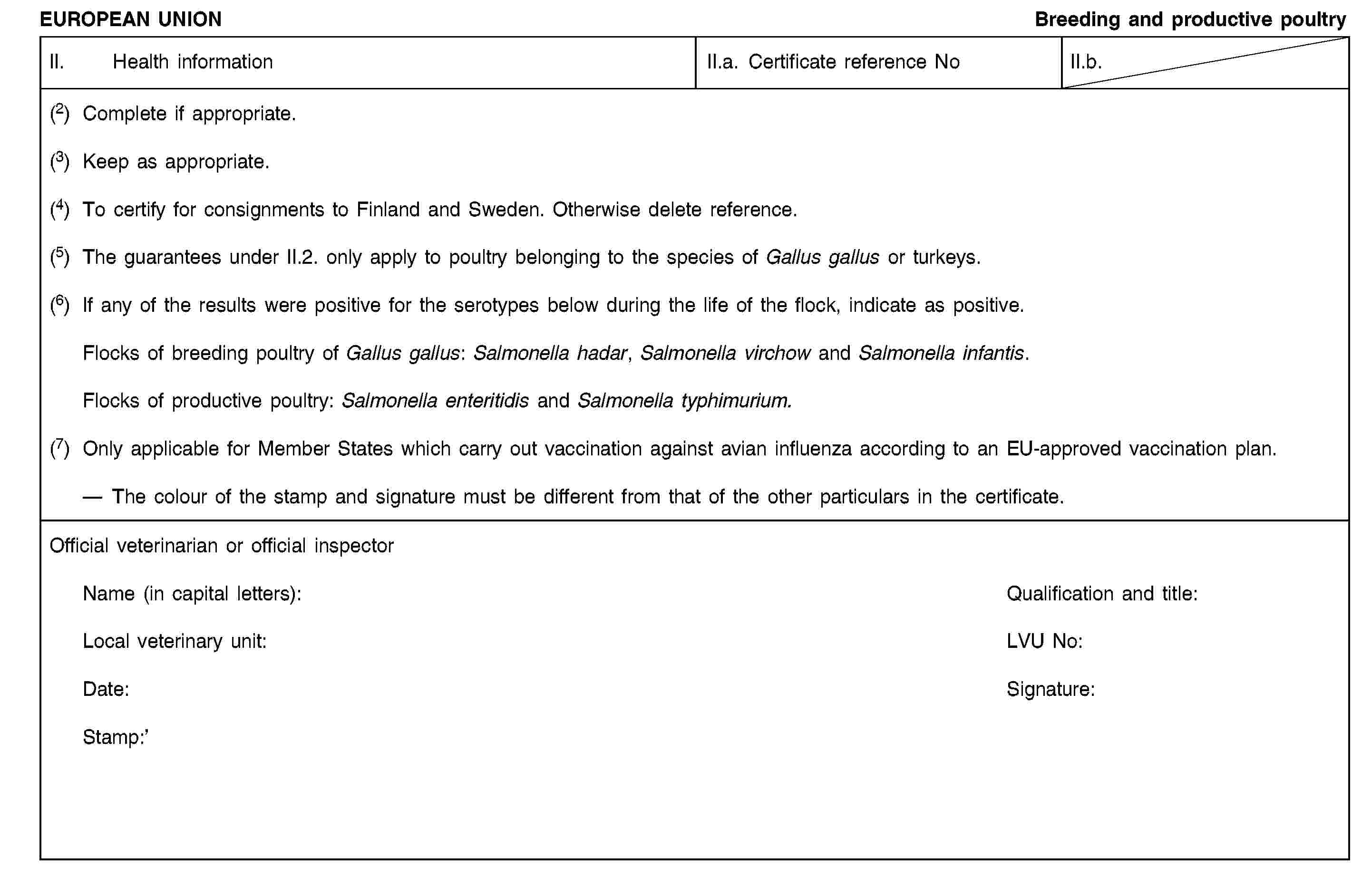
MODEL 4
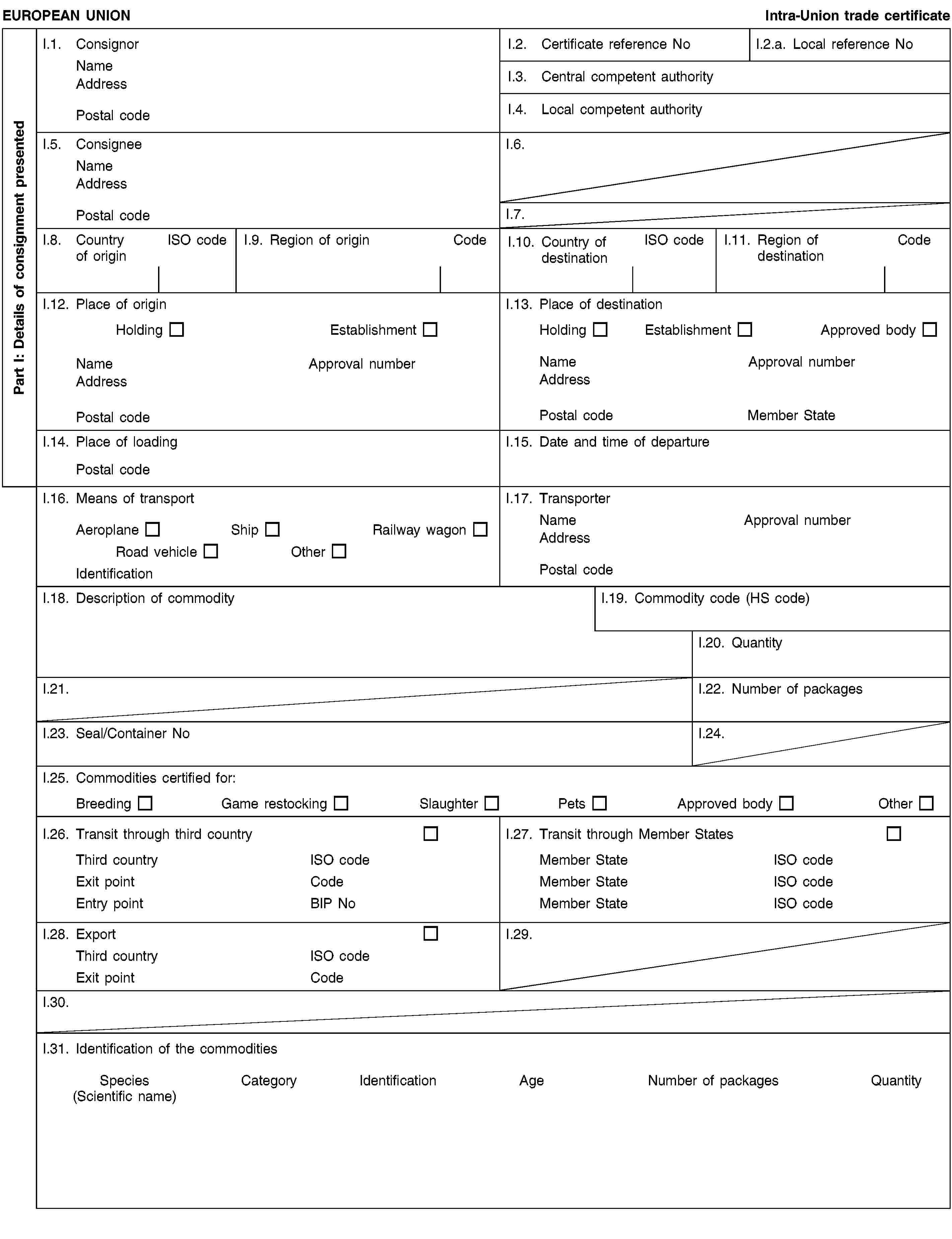
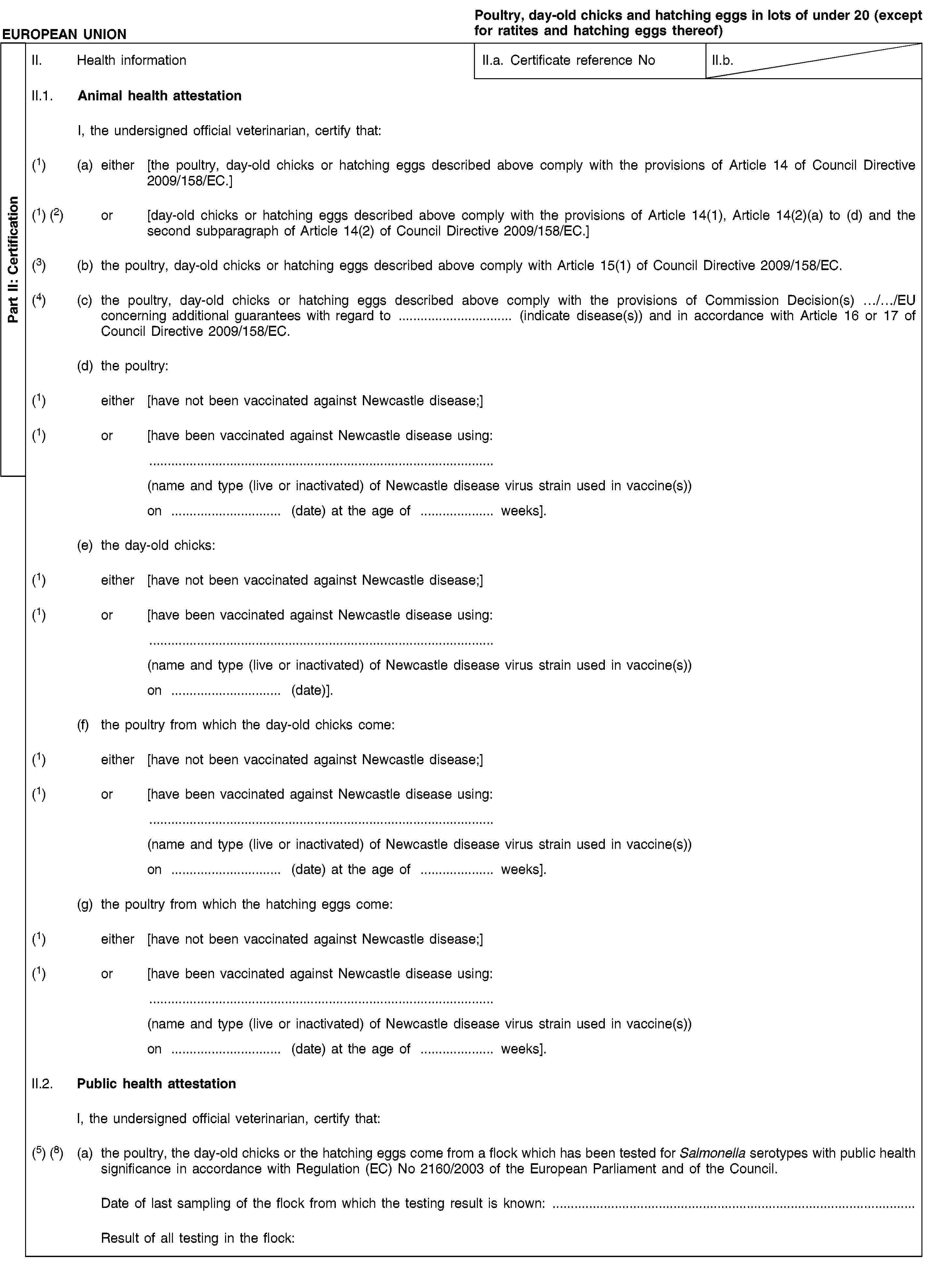
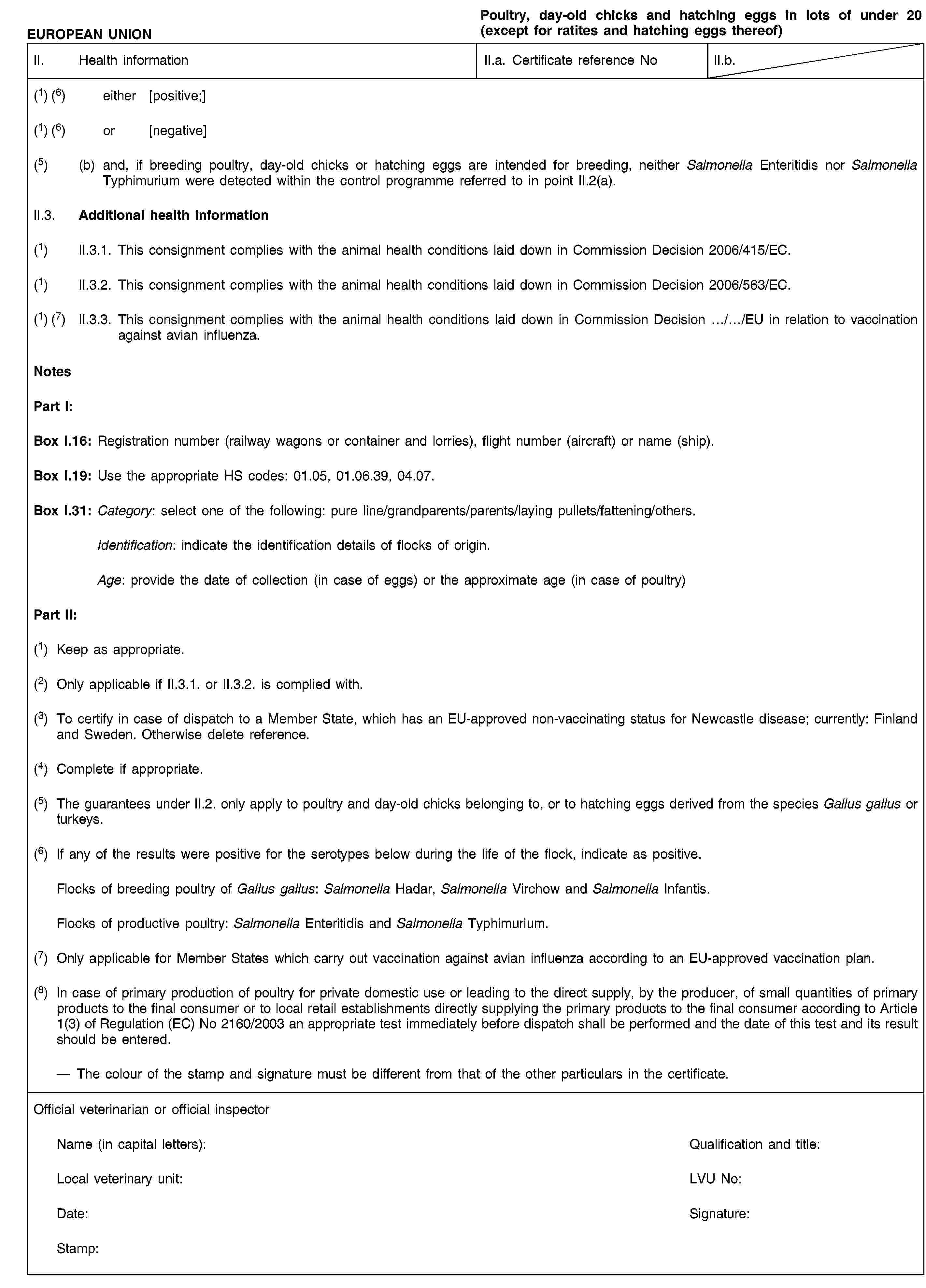
MODEL 5

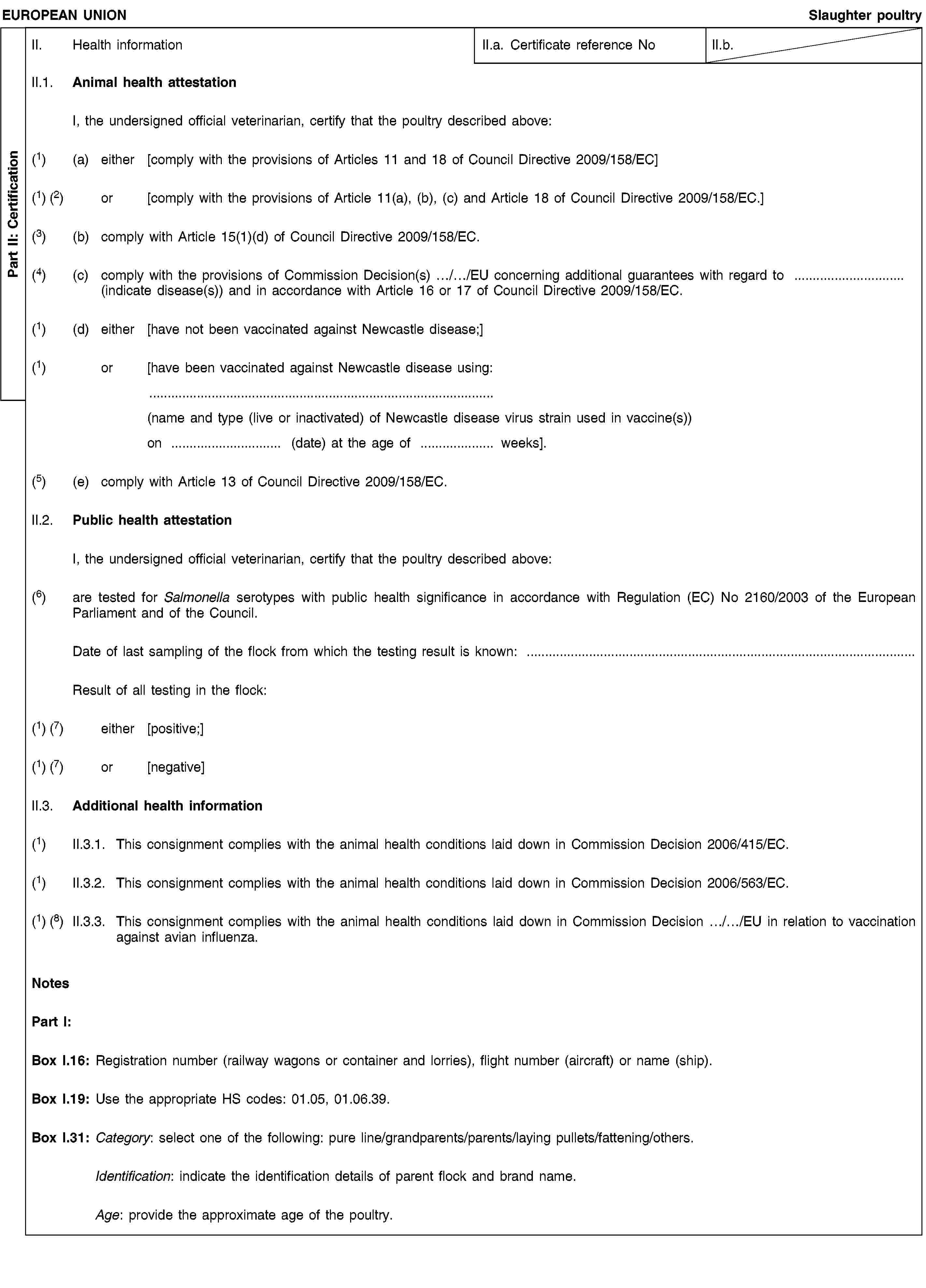
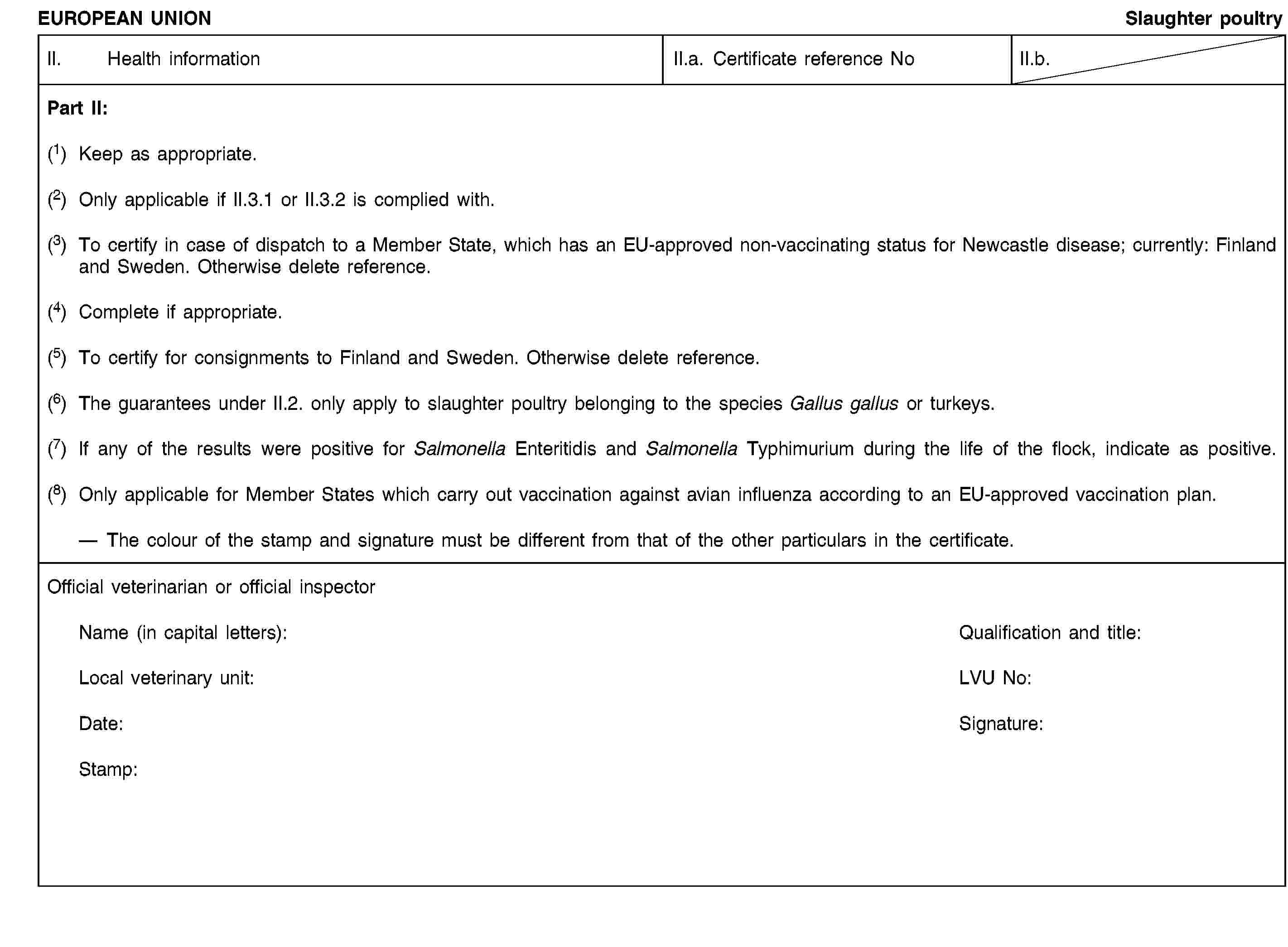
MODEL 6
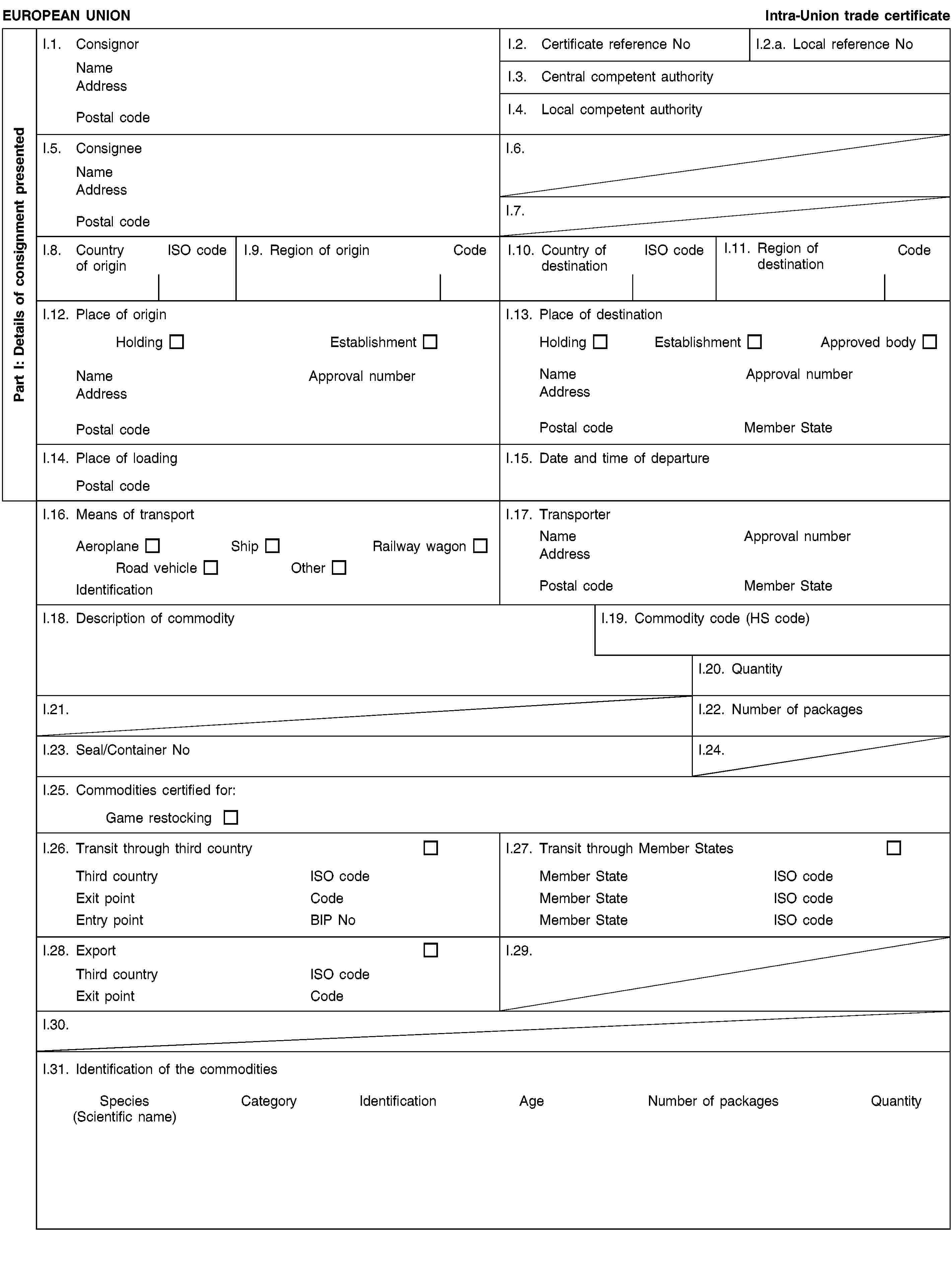
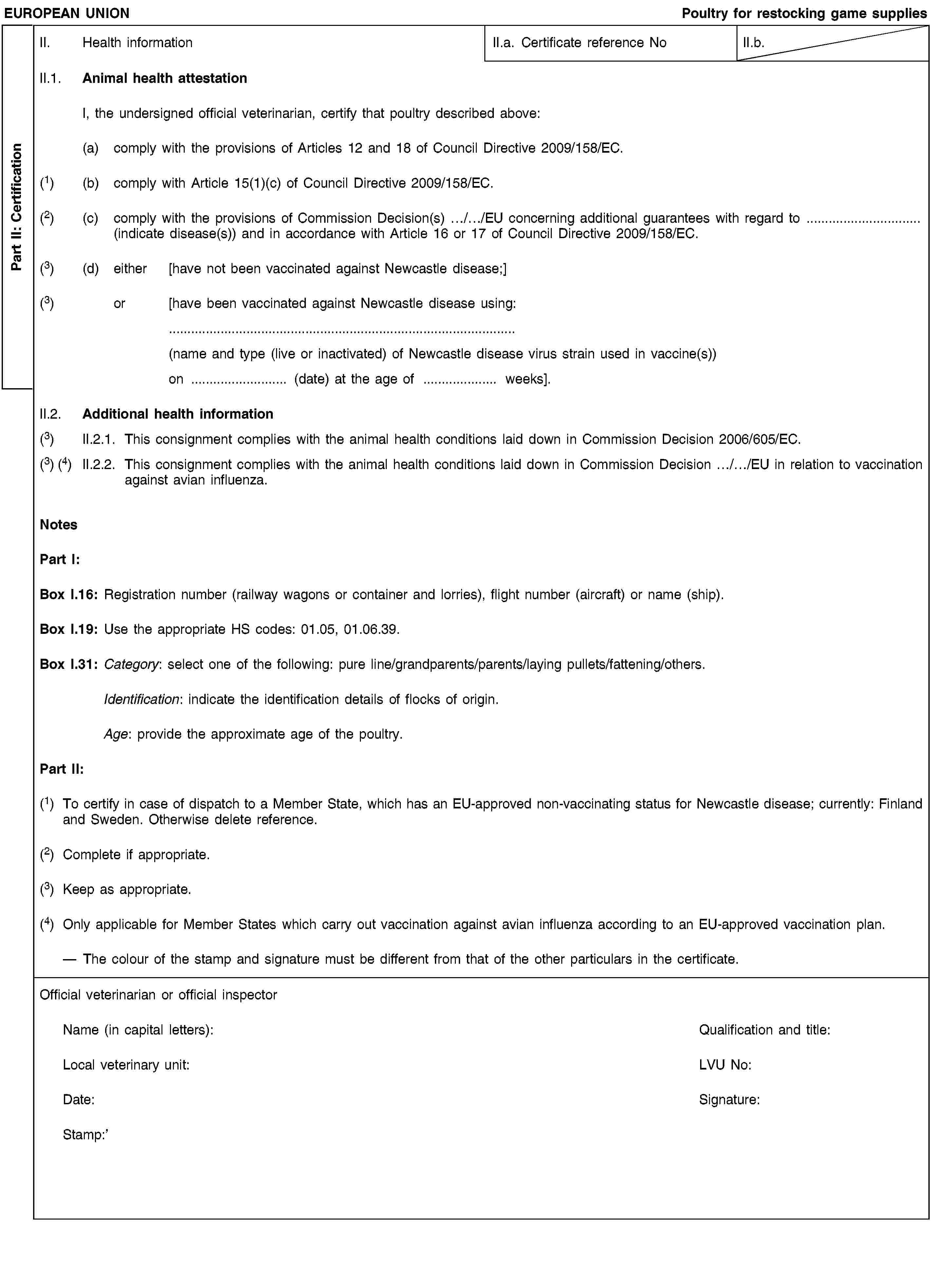
ANNEX V
COMPULSORILY NOTIFIABLE DISEASES
- Avian influenza,
- Newcastle disease,
ANNEX VI
PART A
Repealed Directive with list of its successive amendments (referred to in Article 36)
| Council Directive 90/539/EEC (OJ L 303, 31.10.1990, p. 6). | |
| Council Directive 91/494/EEC (OJ L 268, 24.9.1991, p. 35). | only Article 19(2) |
| Council Directive 91/496/EEC (OJ L 268, 24.9.1991, p. 56). | only as regards the reference to Directive 90/539/EEC in Article 26(2) |
| Council Directive 92/65/EEC (OJ L 268, 14.9.1992, p. 54). | only Article 7(B), second subparagraph |
| Commission Decision 92/369/EEC (OJ L 195, 14.7.1992, p. 25). | |
| Council Directive 93/120/EC (OJ L 340, 31.12.1993, p. 35). | |
| 1994 Act of Accession, Annex I, Points V.E.I.2.A.4 (OJ C 241, 29.8.1994, p. 132). | |
| Council Directive 1999/90/EC (OJ L 300, 23.11.1999, p. 19). | |
| Commission Decision 2000/505/EC (OJ L 201, 9.8.2000, p. 8). | only Article 1 and Annex |
| Commission Decision 2001/867/EC (OJ L 323, 7.12.2001, p. 29). | |
| Council Regulation (EC) No 806/2003 (OJ L 122, 16.5.2003, p. 1). | only Annex III, point 13 |
| 2003 Act of Accession, Annex II, Point 6.B.I.17 (OJ L 236, 23.9.2003, p. 381). | |
| Council Directive 2006/104/EC (OJ L 363, 20.12.2006, p. 352). | only Annex, point I.3 |
| Commission Decision 2006/911/EC (OJ L 346, 9.12.2006, p. 41). | only Annex, point 4 |
| Commission Decision 2007/594/EC (OJ L 227, 31.8.2007, p. 33). | |
| Commission Decision 2007/729/EC (OJ L 294, 13.11.2007, p. 26). | only Annex, point 2 |
| Council Directive 2008/73/EC (OJ L 219, 14.8.2008, p. 40). | only Article 11 |
PART B
List of time-limits for transposition into national law (referred to in Article 36)
| Directive | Time-limit for transposition |
| 90/539/EEC | 1 May 1992 |
| 91/494/EEC | 1 May 1992 |
| 91/496/EEC | 1 July 1992 |
| 92/65/EEC | 31 December 1993 |
| 93/120/EC | 1 January 1995 |
| 1999/90/EC | 30 June 2000 |
| 2006/104/EC | 1 January 2007 |
| 2008/73/EC | 1 January 2010 |
ANNEX VII
CORRELATION TABLE
| Directive 90/539/EEC | This Directive |
| Article 1 | Article 1 |
| Article 2, first paragraph | Article 2, first paragraph |
| Article 2, second paragraph, points (1) to (14) | Article 2, second paragraph, points (1) to (14) |
| Article 2, second paragraph, point (16) | Article 2, second paragraph, point (15) |
| Article 2, second paragraph, point (17) | Article 2, second paragraph, point (16) |
| Article 3(1) | Article 3(1), first subparagraph |
| Article 3(2) | Article 3(1), second subparagraph |
| Article 3(3), first and second indents | Article 3(2)(a) and (b) |
| Article 4 | Article 4 |
| Article 5(a), first subparagraph | Article 5(a), first subparagraph |
| Article 5(a), second subparagraph, first, second and third indents | Article 5(a), second subparagraph, (i), (ii) and (iii) |
| Article 5(b), (c) and (d) | Article 5(b), (c) and (d) |
| Article 6(1)(a), (b) and (c) | Article 6(a)(i), (ii) and (iii) |
| Article 6(2) | Article 6(b) |
| Article 6a | Article 7 |
| Article 7, first paragraph, point (1), first indent | Article 8(1)(a)(i) |
| Article 7, first paragraph, point (1), second indent | Article 8(1)(a)(ii) |
| Article 7, first paragraph, point (1), second indent, first subindent | Article 8(1)(a)(iii), first indent |
| Article 7, first paragraph, point (1), second indent, second subindent | Article 8(1)(a)(iii), second indent |
| Article 7, first paragraph, point (2) | Article 8(1)(b) |
| Article 7, first paragraph, point (3) | Article 8(1)(c) |
| Article 7, second paragraph | Article 8(2) |
| Article 8 | Article 9 |
| Article 9 | Article 10 |
| Article 9a | — |
| Article 9b | — |
| Article 10 | Article 11 |
| Article 10a | Article 12 |
| Article 10b | Article 13 |
| Article 11(1) | Article 14(1) |
| Article 11(2), first to fifth indents | Article 14(2), first subparagraph, points (a) to (e) |
| Article 11(2), sixth indent | Article 14(2), second subparagraph |
| Article 11(3) | Article 14(3) |
| Article 12(1)(a), first, second and third indents | Article 15(1)(a)(i), (ii) and (iii) |
| Article 12(1)(b), first and second indents | Article 15(1)(b)(i) and (ii) |
| Article 12(1)(c), first, second and third indents | Article 15(1)(c)(i), (ii) and (iii) |
| Article 12(1)(d), first and second indents | Article 15(1)(d)(i) and (ii) |
| Article 12(2), first, second and third subparagraphs | Article 15(2), first, second and third subparagraphs |
| Article 12(2), fourth subparagraph, first, second and third indents | Article 15(2), fourth subparagraph, points (a), (b) and (c) |
| Article 12(2), fifth subparagraph | — |
| Article 12(3)(i) and (ii) | Article 15(3)(a) and (b) |
| Article 13(1), first to seventh indents | Article 16(1)(a) to (g) |
| Article 13(2), first subparagraph | Article 16(2) |
| Article 13(2), second subparagraph | — |
| Article 13(3) | Article 16(3) |
| Article 13(4) | — |
| Article 14(1), first to fifth indents | Article 17(1)(a) to (e) |
| Article 14(2) | Article 17(2) |
| Article 14(3) | Article 17(3) |
| Article 14(4) | — |
| Article 15(1), first subparagraph, first and second indents | Article 18(1)(a) and (b) |
| Article 15(1), second subparagraph, point (a) | Article 18(2)(a) |
| Article 15(1), second subparagraph, point (b), first to fourth indents | Article 18(2)(b)(i) to (iv) |
| Article 15(2) | Article 18(3) |
| Article 15(3), first and second indents | Article 18(4)(a) and (b) |
| Article 15(4)(a) | Article 18(5), first subparagraph |
| Article 15(4)(b) | Article 18(5), second subparagraph |
| Article 15(4)(c) | Article 18(5), third subparagraph |
| Article 15(5), first, second and third indents | Article 18(6)(a), (b) and (c) |
| Article 15(6) | Article 18(7) |
| Article 16 | Article 19 |
| Article 17, first to seventh indents | Article 20(a) to (g) |
| Article 18 | Article 21 |
| Article 20 | Article 22 |
| Article 21 | Article 23 |
| Article 22(1) | Article 24(1) |
| Article 22(2) | — |
| Article 22(3) | Article 24(2) |
| Article 23 | Article 25 |
| Article 24 | Article 26 |
| Article 25 | Article 27 |
| Article 26 | Article 28 |
| Article 27a | Article 29 |
| Article 28 | Article 30 |
| Article 29(1) | Article 31 |
| Article 30(1) | Article 32 |
| Article 30(2) | — (1) |
| Article 31 | — |
| Article 32(1) | Article 33(1) |
| Article 32(2) | Article 33(2) |
| Article 32(3) | — |
| Article 33(1) | — |
| Article 33(2) | Article 33(3) |
| Article 34 | Article 34 |
| Article 36 | — |
| — | Article 35 |
| — | Article 36 |
| — | Article 37 |
| Article 37 | Article 38 |
| Annex I, point 2 | Annex I |
| Annex II, Chapters I, II and III | Annex II, Chapters I, II and III |
| Annex II, Chapter IV, points 1 and 2 | Annex II, Chapter IV, points 1 and 2 |
| Annex II, Chapter IV, point 3(a) | Annex II, Chapter IV, point 3(a) |
| Annex II, Chapter IV, point 3(b)(i) and (ii) | Annex II, Chapter IV, point 3(b), first and second indents |
| Annexes III, IV and V | Annexes III, IV and V |
| — | Annex VI |
| — | Annex VII |
| (1) Amending Directive 90/425/EEC. | |
( 1 ) Opinion of 20 October 2009 (not yet published in the Official Journal).
( 2 ) OJ L 303, 31.10.1990, p. 6.
( 3 ) See Annex VI, Part A.
( 4 ) OJ L 299, 16.11.2007, p. 1.
( 5 ) OJ L 168, 28.6.2008, p. 5.
( 6 ) OJ L 224, 18.8.1990, p. 29.
( 7 ) OJ L 184, 17.7.1999, p. 23.
( 8 ) OJ L 139, 30.4.2004, p. 321.
( 9 ) OJ L 378, 31.12.1982, p. 58.
( 10 ) OJ L 243, 11.10.1995, p. 25.
( 11 ) OJ L 260, 5.9.1992, p. 1.
( 12 ) OJ L 94, 31.3.2004, p. 44.
( 13 ) OJ L 10, 14.1.2006, p. 16.
( 14 ) OJ L 395, 30.12.1989, p. 13.
( 15 ) OJ L 31, 1.2.2002, p. 1.
( 16 ) Salmonella Pullorum means Salmonella enterica subspecies enterica serovar Gallinarum biochemical variant (biovar) Pullorum.
( 17 ) Salmonella Gallinarum means Salmonella enterica subspecies enterica serovar Gallinarum biochemical variant (biovar) Gallinarum.
( 18 ) Salmonella arizonae means Salmonella enterica subspecies arizonae serogroup K (O18) arizonae.
( 19 ) Note that serological testing in avian species other than fowls may sometimes result in an unacceptable proportion of false-positive reactions.
( 20 ) Note that environmental samples are generally not suitable for reliable detection of Salmonella pullorum and Salmonella gallinarum, but are suitable for Salmonella arizonae.
( 21 ) Note that direct plating of aseptically collected tissues on to a minimally selective agar, such as MacConkey agar, is also useful for diagnosis.
( 22 ) Salmonella pullorum and Salmonella gallinarum do not readily grow in the modified semi-solid Rappaport Vassiliadis (MSRV) medium that is used for monitoring of zoonotic Salmonella spp. in the Union, but it is suitable for Salmonella arizonae.
( 23 ) Note that there is currently no test that can differentiate between the response to Salmonella Pullorum and Salmonella Gallinarum infection and vaccination for this serotype.
( 24 ) OJ L 311, 28.11.2001, p. 1.
Lábjegyzetek:
[1] A dokumentum eredetije megtekinthető CELEX: 32009L0158 - https://eur-lex.europa.eu/legal-content/HU/ALL/?uri=CELEX:32009L0158&locale=hu Utolsó elérhető, magyar nyelvű konszolidált változat CELEX: 02009L0158-20120201 - https://eur-lex.europa.eu/legal-content/HU/ALL/?uri=CELEX:02009L0158-20120201&locale=hu


